![[Title page]](images/illus-003_tn.jpg)
The Project Gutenberg EBook of The Postage Stamp in War, by Fred. J. Melville This eBook is for the use of anyone anywhere at no cost and with almost no restrictions whatsoever. You may copy it, give it away or re-use it under the terms of the Project Gutenberg License included with this eBook or online at www.gutenberg.org Title: The Postage Stamp in War Author: Fred. J. Melville Release Date: September 27, 2010 [EBook #34007] Language: English Character set encoding: ISO-8859-1 *** START OF THIS PROJECT GUTENBERG EBOOK THE POSTAGE STAMP IN WAR *** Produced by Simon Gardner, Adrian Mastronardi, The Philatelic Digital Library Project at http://www.tpdlp.net and the Online Distributed Proofreading Team at https://www.pgdp.net
Transcriber's Notes:
Irregular ordering and duplicate numbering of figures are retained as in the original. In this HTML version cross-reference hyperlinks to figures are not provided when the figure is adjacent to the paragraph where the reference occurs.
Minor inconsistencies in punctuation and formatting in the original are retained. Detailed corrections and observations on the text are listed at the end of the book.
By the same Author.
A new work on the postage stamps of the new British Protectorate of
EGYPT
in the Melville Stamp Book series (No. 20) is now on the press and will be published in January, 1915, by Stanley Gibbons, Ltd., 391 Strand, W.C. Price 6d. Post free, 7½d.[Pg 3]
... The ...
Postage Stamp
in War
by
FRED J. MELVILLE,
Editor of "The Postage Stamp."
MDCCCCXV - PUBLISHED - BY - FRED.
J. - MELVILLE, - 14 - SUDBOURNE - RD.,
BRIXTON, - LONDON, - ENGLAND.
COPYRIGHT. All rights of translation and reproduction reserved.
To many collectors and dealers we are indebted for the loan of stamps, envelopes, etc., for illustration in this work, including Messrs. E. Bentley Wood, H. H. Harland, W. J. Holmes, Nathan Heywood, J. Ireland, R. Wedmore, Stanley Gibbons, Ltd., Hugo Griebert & Co., Alfred Smith & Son, W. T. Wilson, Whitfield King & Co., Charles Nissen & Co., Lewis May & Co., W. S. Lincoln & Son, Bright & Son, R. Roberts, Bridger & Kay, A. C. Roessler, C. Davies, and others.
Captain Lionel Crouch has kindly assisted in revising the proofs.
| Chapter I. | |
The Postage Stamp with the Flag.—British Posts in the Crimea—The Abolition of the Capitulations—The British Fleet in the Baltic— Abyssinian Expedition—The First Army Postal Corps—Egypt— Dongola Expedition—South Africa—The British Army Post in France, 1914—How to Address Soldier's Letters—The Postmarks from France— The Navy's Postmarks. | Page 7. |
| Chapter II. | |
Indian Army Postal Service—China Expeditionary Force—British Railway Administration in China—Somaliland—The Forbidden City of Lhassa—Indian Expeditionary Force in France. | Page 28. |
| Chapter III. | |
South African Wars—Transvaal—Orange River Colony—Krugersdorp— Kuruman—Lydenburg—Mafeking—Pietersburg—Rustenburg—Schweizer Renecke—Volksrust—Vryburg—Wolmaranstad—The Union—South African War of 1914. | Page 37. |
| Chapter IV. | |
France—Napoleon's Minister of Posts—The Second Republic—The Presidency—Empire—French Expeditions to China and Mexico—Sedan— Metz—Strasburg—The Siege of Paris—Balloon Post—Pigeon Post— Peace—Military Frank Stamps—The German Invasion, 1914—Red Cross Stamps—War Postcards and Postmarks. | Page 49. |
| Chapter V. | |
Russia—War Charity Stamps—Portraits of the Tsars—War Stamps of 1914—Japan—War with China—The Empress Jingo—Triumphal Military and Naval Reviews—Kiao-chow—Belgium—King Albert— Bombardment of Malines—Private Postal Service—Germanised Posts— Red Cross Stamps—Bogus Stamps—Postmarks—Serbia—"Death Mask" Stamps—King Peter—Montenegro—King Nicholas. |
Page 59. |
| Chapter VI. | |
The Enemy's Stamps—Germany—Austria—Bosnia—Hungary—Turkey. |
Page 75. |
| Chapter VII. | |
American Wars.—United States—Civil War—Confederate Stamps— Hispano-American War—Vera Cruz—Canada—Mexican Revolution— South and Central America. | Page 91. |
| Chapter VIII. | |
Miscellaneous Wars and Commemorations—Patriotic Empire Stamps— Victoria—New Zealand—Barbados' Nelson Stamp—A Dutch Naval Commemoration—Balkan Wars—Greece—Albania—Epirus—Bulgaria— Roumania—Italy—Portugal—Spain—Mysterious Melillas—China. |
Page 100. |
| Chapter IX. | |
The Great War of 1914-1915. Check List of New War Stamps. |
Page 113. |
THE POSTAGE STAMP IN WAR.
The Postage Stamp with the Flag. — British Posts in the Crimea — The Abolition of the Capitulations — The British Fleet in the Baltic — Abyssinian Expedition — The First Army Postal Corps — Egypt — Dongola Expedition — South Africa — The British Army Post in France, 1914 — How to Address Soldier's Letters — The Postmarks from France — The Navy's Postmarks.
The Postage Stamp follows the Flag. The same small talisman which passes our letters across the seven seas to friends the world over maintains the lines of personal communication with our soldiers and sailors in time of war. Wherever the British Tommy goes he must have his letters from home; like the lines of communication, which are the life-line of the army, postal communication is the chief support of the courage and spirit of the individual soldier. His folk at home send him new vigour with every letter that tells of the persons, places and things that are nearest and most cherished in his memory.
In these days letter-sending and letter-getting are so common-place that few give any thought to the great organisation by which thousands of millions of postal packets are posted and delivered in this country every year. And now that most of us have friends at the Front, in France, in Belgium, or on the high seas, we are perhaps inclined to take it all just as a matter of course that letters pass and repass much in the ordinary humdrum way. This is plain to the conductors of our postal services when during war time they get numerous complaints from individuals of delay or even non-delivery, or any one of a number of other minor inconveniences which must often be unavoidable in the stirring times of war.
To-day many thousands of letters and postal packets are being sent to and received from the troops of the British Expeditionary Force in France, yet it is a simple fact that[Pg 8] but a small percentage of the civilian population in this country knows anything of the existence, far less of the workings, of the Army Postal Service as an organisation separate and distinct from the postal department of the home Government. The Army Postal Service is administered under a Director of Postal Services, who is responsible to the Commander in Chief of the Army, and whose system is established with the co-operation of the Inspector-General of Communications.
The formation of a British Army Post Office Corps is of comparatively recent date. It was first suggested by Colonel du Plat Taylor in the seventies, as a means of using the services of the Post Office Rifle Volunteers in war time, but it was not until the Egyptian campaign in 1882 that the corps was formed.
Prior to this, however, bodies of servants of the Post Office had done duty with the army in organising and maintaining postal communication with the armies in the field and with the links connecting up with the home service. During the Crimean War extensive arrangements were made by the Post Office to maintain postal communication with the forces in Turkey, the Black Sea, and the Baltic. Prior to the war, the British Government did not maintain any postal packets between Mediterranean ports save some steam vessels for the transport of the Indian mails, and some of these were taken up by the military and naval authorities. Letters for Constantinople and the Levant ordinarily went through the French and Austrian administrations and were chargeable at the then high foreign rates of postage. With the assistance of the French Government, letters were sent viâ Marseilles to Constantinople (or vice-versâ) at first at intervals of three times a month, but afterwards six times a month, and during the latter period of the war, twice a week.
But the French mail packets went no further than Constantinople, so the British Postmaster-General sent out an experienced officer, Mr. E. J. Smith, of the London General Post Office, to Turkey as Postmaster of His Majesty's Forces; and three Assistant Postmasters, together with seven Letter Sorters. As the facilities for land transport accorded the Postmaster proved insufficient he was furnished with eighteen horses and mules for the exclusive use of his office. The Postmaster was supplied with the postage stamps of the home country, then (so far as the penny and twopence denominations[Pg 9] were concerned) in the early and beautifully engraved design of William Wyon's "Queen's Head." This was the first use of British postage stamps on foreign territory, or indeed anywhere beyond the limits of the British Isles, and stamp collectors take a considerable interest in the English stamps which survive with the various Crimean postmarks specially supplied to the Postmaster of His Majesty's Forces in the East. Stamps used on letters from the forces may be recognised by either the Crown and Stars or Cypher and Stars or the circular dated postmarks (Figs. 1-4). A range of the early penny red stamps, from the imperforate red-brown stamp of 1841 to the Die II. large Crown perforated 14 stamp may be found, as well as the twopence blues of the same period, and the 4d. rose (1857), 6d. violet (1854), and 1s. green (1847) (see Figs. 5-10). There are possibly others not yet known to collectors.
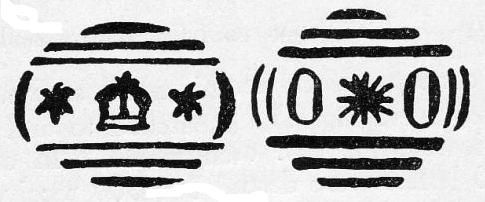 1 2
1 2
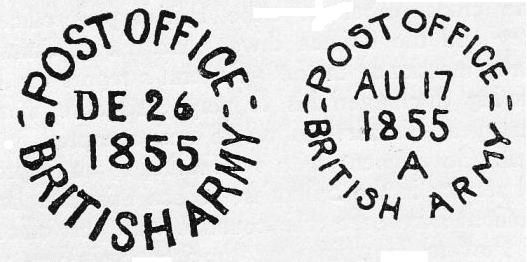 3 4
3 4 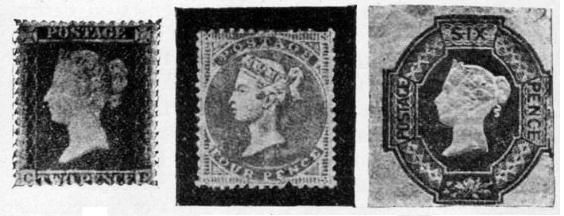 8 9 10
8 9 10The correspondence dealt with by this small staff was considerable, averaging 45,250 letters despatched to and 43,125 received from the seat of war in each month. In one year 543,000 letters were despatched to and 517,500 received from the forces in the Crimea.
The chief officer in charge at the British post offices in Turkey and the Crimea during the war, Mr. E. J. Smith, is specially mentioned in the Postmaster-General's report for 1857 as having discharged his duties in a very creditable manner. In that year his services were offered to and accepted by the Turkish Government with a view to establishing an improved postal service in the Sultan's dominions. Since this date British post offices have been maintained (in common with post offices of other Powers) in various parts of the Turkish dominions, using British stamps with or without a special overprint. These offices were closed in October, 1914, as a result of Turkey's declaration of the "abolition of the Capitulations," just prior to Turkey's open acts of war against the allied forces of Great Britain, France, and Russia in the present war.
Ordinary British stamps used at the British post-offices in the Ottoman Empire may be distinguished by postmarks (Figs. 11-17).
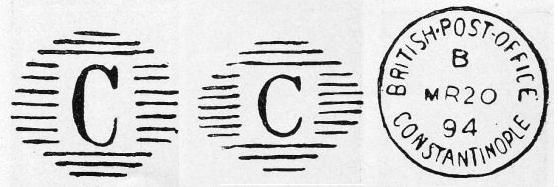 11 12 13
11 12 13 14 15 16 17
14 15 16 17The first three are from Constantinople, the fourth and fifth from Smyrna, and the last two Beyrout. There are also "S" Stamboul, "B01" Alexandria, "B02" Suez, as well as ordinary date stamps of all these places.
The following are illustrations of samples of the stamps which were in use at the British post-offices in Turkey at the time of the abolition of the Capitulations. (Figs. 18, 19).
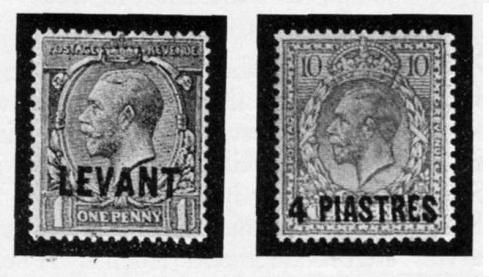 18 19
18 19
Special arrangements were also made for maintaining postal communications with the British Fleet in the Baltic, the stamps used being distinguishable by postmarks of diamond-shaped internal configuration (Fig. 20). It is possible that date marks of Dantzig may also be found on British stamps of this period; they appear on the covers of letters bearing British stamps with the diamond cancellations. In the early part of the naval campaign letters were transmitted[Pg 12] exclusively by war vessels or transports, but in the beginning of May, 1854, when the greater part of the Fleet had reached its destination the Admiral commanding in chief was directed to establish regular weekly communication by steamer between the ships under his command and the port of Dantzig. Mails for the Fleet were despatched from London every Tuesday to Dantzig, under cover of a bag addressed to Her Britannic Majesty's Consul at that port, who handed the bag over to the commander of the steamer which was timed to arrive at Dantzig each Friday. This arrangement, while satisfactory in respect of speed and regularity, involved the charging of the high foreign rates of postage, as the route was through Belgium and Prussia, but, as often as facilities offered, mails were made up for transmission by Government transports passing to and from England and the Baltic, by which soldiers and sailors were able to send and receive letters at their privilege rate of one penny each.
Abyssinian Expedition. The following is the type of date stamp used by the British post-office corps accompanying Sir Robert Napier's successful expedition to Abyssinia in 1867-1868 (Fig. 21).
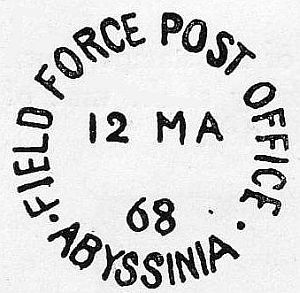 21
21
The Indian Government sent an army postal corps to Abyssinia, the mails to and from the United Kingdom connecting up with the vessels carrying the Indian mails off Jubbel Teer in the Red Sea. The late Mr. J. G. Hendy of the G.P.O. Muniment Room records[1] that, in April 1868, a direct weekly mail service was established between Suez and Zoulla. The rates for letters under half an ounce were the same as to India, viz.:
| Viâ Southampton. | Viâ Marseilles. | |
| Officers of Army or Navy, | 6d. | 10d. |
| Soldiers and Seamen, | 1d. | 5d. |
| For persons serving on board transports or other persons not belonging to the naval or military forces, | 9d. | 1s. 1d. |
He also states that naval and military officers, when serving on colonial or foreign stations, were permitted, under Treasury[Pg 13] Warrant of May 16, 1857, to send or receive letters at the reduced British postage of 6d. per ounce, in all cases where the postage of ordinary letters to or from the same place was higher than 6d. The privilege was withdrawn on January 1, 1870, and then letters became liable to the general rates of postage.
[1] "The Postmarks of the British Isles from 1840." By J. G. Hendy. London, 1909; p. 13.
Egypt. The organisation of an Army Postal Corps was authorised on July 18, 1882, for service in Egypt, and it was promptly completed. Colonel du Plat Taylor was instructed to form the corps of two officers and one hundred men from the Post-Office Volunteers (24th Middlesex) for enrolment in the first-class Army Reserve. The men combined the advantages of experience in postal work, as sorters and postmen, with army training. The officers selected were Major Sturgeon (of the Money Order Office) and Captain Viall (Receiver and Accountant General's Department), the former taking command with the army rank of Captain, and the latter seconding him, with the army rank of Lieutenant. The men received their post-office pay, and, while on active service, in addition to free kit and rations, the privates drew army pay of 1s., corporals 1s. 8d., and sergeants 2s. 4d. per day.
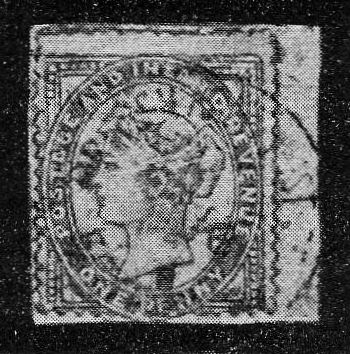 22
22
The famous blind Postmaster-General, Henry Fawcett, inspected the corps at the General Post Office on July 26, and the officers with 50 men sailed on August 8, disembarking at Alexandria on August 21. Their first postal duties were undertaken at Alexandria and Ramleh, but two days after disembarkation they re-embarked, joining up with Lord Wolseley's main forces at Ismailia on August 26. The base was at Ismailia, whence the post office corps sent out its branches, planting advanced base and field post offices connecting the base with the changing front, between which and the base a daily service was maintained. In September, shortly after the battle of Tel-el-Kebir, the Army and the Army Post Office reached Cairo, and re-embarked for home on October 7. The despatches gave high praise to the efficiency and useful service of the corps.[Pg 14]
Three years later, Major Sturgeon (promoted in recognition of his services in Egypt, 1882) again commanded a corps of twenty N.C.O.'s and men, in Sir Gerald Graham's Suakim expedition of 1885. The corps left England on March 3, and returned on July 28, after a more difficult experience with the Suakim garrison than they had met with in the first Egyptian campaign.
Dongola Expedition. Of the Dongola Expeditionary Force under General Kitchener in 1896 we have no record of the use of English stamps, but Mr. H. H. Harland has shown us an interesting envelope with the postmark of Wadi-Halfa camp, the letter not being prepaid as no stamps were available (Fig. 23).
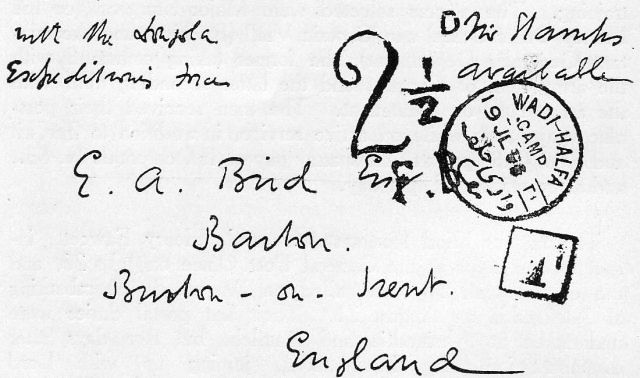 Fig. 23. Dongola Expeditionary Force.
Fig. 23. Dongola Expeditionary Force.
South Africa, 1899-1902. Major Sturgeon was succeeded in the command of the Army Postal Corps by his second in command, Captain Viall. On the death of the latter (1890), Captain G. W. Treble of the London Postal Service took the command, which he held at the outbreak of the South African War in 1899, aided by Captain W. Price (now Colonel W. Price, C.M.G., in command of the Army Post Office with the British Expeditionary Force in France) and Lieutenant H. M'Clintock, these latter officers belonging to the Secretary's Office of the G.P.O., London. A first portion of the company, with Captain Treble, left England with General Buller and his staff, and the rest followed on October 21, and several[Pg 15] further detachments went out with later contingents. In South Africa they had a very wide area to cover. At the outset Captain Treble established himself with the headquarters of the Inspector General of Communications in Cape Colony, and moved about keeping close touch with the movements of the forces, an important part of his duties being to forward to the various offices the information necessary to ensure the correct circulation of the mails. Captain Price was at Cape Town, and Lieutenant M'Clintock at Pietermaritzburg.
The British military mails were made up in the London G.P.O. in special bags addressed to the Army Post Office, and sent to the G.P.O. at Cape Town, in which building the detachment of the Army Postal Corps under Captain Price had established its base office. The bags containing military mails were handed over to the Army Base Post Office at Cape Town whence they were distributed to the various military post offices established at the centres of the troops, and to field post offices with each Brigade or Division in the field. In the return direction the soldiers' letters were handed in at field post offices and forwarded through various channels, sometimes ordinary and ofttimes military to the base at Cape Town, whence they were despatched to England in the ordinary way.
Early in 1900 the average weekly mail from London to the Field Forces was 150 bags of letters, postcards, etc., and 60 boxes of parcels; the incoming mail from the Field Forces was 11 bags of letters per week. In a letter dated from Cape Town, February 27, from Lieutenant Preece, who went out with reinforcements for the Army Post Office Corps in February, are some interesting glimpses of the difficulties of the work of this service[2]:
"Price, of the Post Office Corps, met us and told us (Captain) Palmer was to leave at once for Kimberley with 17 men (Captain) Labouchere and (Lieut.) Curtis to proceed on to Natal with 50 men, and I was to take the remainder ashore here (Cape Town) and stop to help at the base. At 9.30 on Monday morning I marched off with my 57 men to the main barracks and bid good-bye to the good ship 'Canada' and her merry cargo. After lodging the men in barracks I went off to the G.P.O., where I found Price and his 40 men ensconced in one huge wing, overwhelmed with work, and at breaking-down point. The mails every week increase now, and we have 250,000 pieces of mail matter to sort and distribute every week, over a country larger than France, among a shifting population of soldiers, each of whom expects to get his letters as easily as he gets his rations. It is a vast job, and we have done wonderfully[Pg 16] so far with a totally inadequate staff. We have come in the nick of time. The recent movements (the advance of Lord Roberts from Modder River, relief of Ladysmith, etc.) have caused chaos among our mails. We receive and send telegrams every hour either to a field post office or to headquarter staffs. The latter order immediate reinforcement at Modder River, and Price has decided to send me up with more men to proceed to Paardeberg, or wherever the troops are, to get things straight."
[2] St. Martins le Grand, vol. x., page 201.
The preliminary arrangements necessitated by the vast area of the operations provided for two base offices, the one in Cape Colony and the other in Natal, and 43 field post offices, and by June, 1900, the Army Postal Corps was composed of ten officers and 400 N.C.O.'s and men, exclusive of post office telegraphists, etc., serving with the Royal Engineers. Many interesting statistics of the mails at different periods of the war have been given in various records, but it will suffice to quote some general ones on the authority of the Postmaster-General. His forty-sixth report, 1900, states:
During eight months of the Crimean War, 362,000 letters were sent out, and 345,000 were sent home. During a similar period of the war in South Africa 5,629,938 letters were sent out, and 2,731,559 were sent home.
The work of the corps was not undisturbed by the depredations of the enemy, and not infrequently the members of the corps had to defend the mails in their charge along with the guards provided by the military. On June 7, 1900, General De Wet, who has lately extinguished the admiration in which Britons held him for his brilliant and elusive tactics, by his treachery in the present war, swooped down with 1200 men and 5 guns on Roodewal Station where Lieutenant Preece had 2000 bags, a several weeks' accumulation of mails for Lord Roberts' main army. There were 17 men of the Army Postal Corps, and these, with about 160 men in charge of supplies, etc., had to defend the station. Two of the seventeen were killed, and Lieutenant Preece and the remainder of his gallant little corps were taken prisoners. The 2000 mail bags were used as a barricade. It is recorded that when the gallant little band surrendered, and De Wet, riding an English cavalry horse, came up, the Boer general was most polite and even kind in many ways, and expressed himself as "very sorry to do it," when asked not to destroy the letters and registered parcels. He said if he did not do so, his young Boers would open and read them and turn the letters of the soldiers into ridicule. The bags were opened, the contents strewed about, and the Boers[Pg 17] possessed themselves of the valuables, while tobacco, cigarettes, cakes, chocolates were so plentifully strewed about that the young Boers even invited their prisoners to help themselves, as the General was going to burn everything. And he did burn the entire station.
In his forty-seventh report (1901) the Postmaster-General states:
The Army Post Office is still in operation in South Africa. The staff now consists of 7 officers and about 540 men. The weekly mail for the Army Post Office contains on an average 204,000 letters and 115,300 packets of printed matter; and it is estimated that during the year ended 31st March, 1901, 11,551,300 letters were sent to the troops and 9,250,000 were received from them. During the same period the parcels sent out to the forces in South Africa by post amounted to 534,245, the largest number despatched on any one occasion, namely, on the 1st of December, 1900, being 19,672. About 8745 such parcels are now sent each week.
As to the magnitude and difficulties of the work of the Army Post Office, I cannot do better than quote the following paragraph from Earl Roberts' despatch of the 16th August last:—
"The magnitude of the task set the Military Postal Service may be appreciated when it is realised that the Army Mails from England have exceeded in bulk the whole of the mails arriving for the inhabitants of Cape Colony and Natal, and contained each week little short of 750,000 letters, newspapers, and parcels for the troops. No little credit is therefore due to the department under Major Treble in the first few months, and for the greater part of the time under Lieut.-Colonel J. Greer, Director of Military Postal Services, for the way in which it has endeavoured to cope with the vast quantity of correspondence, bearing in mind the incessant manner in which the troops have been moved about the country, the transport difficulties which had to be encountered, the want of postal experience in the bulk of the personnel of the corps, and the inadequacy of the establishments laid down for the several organisations."
His Majesty has been pleased to confer the honour of C.M.G. on Messrs. Greer and Treble in acknowledgment of their services.
The forty-eighth report (1902) mentions no change of any importance in the Army Postal Service in South Africa, and gives the weekly average mail from England as 184,000 letters and 143,600 packets of printed matter: the total number of letters for the year ended March 31, 1902, was 10,774,000 outward, and 8,372,000 homeward, showing a decrease compared with previous returns. During the same period 528,000 parcels were sent out.
The last official reference to the Army Postal Service in South Africa is contained in the forty-ninth (1903) report, announcing its withdrawal, postal communications with the troops still on service in the old colonies and the new ones being carried on through the Colonial Post Offices under the ordinary regulations. The Peace was declared May 31, 1902.[Pg 18]
The war in South Africa left its impress on many pages of the stamp collector's album, but at this juncture we are chiefly concerned with the immediate work of the British military postal service. Collectors have followed the use of the stamps of the home country into the distant fields of operations by means of the various postmarks which are summarised as follows from the collection of Captain Guy R. Crouch, of the Oxford and Bucks Light Infantry[3]:
[3] The Postage Stamp, vol. XIV., pp. 234-237.
Type 1 (Fig. 24). Office Numbers from 1 to 56, and 100. Used also at Cape Town base with initials BO (Base Office) and an asterisk (sometimes omitted) in lieu of the office number. Also at sub-base offices with larger office numerals 1 to 9.
Type 2 (Figs. 25, 26). Commonly without the year being noted, as in the first illustration but also found with the year[Pg 19] as in the second illustration of this mark. It has been largely supposed, but without much, if any, foundation that these year-less marks originated in Ladysmith during the siege, but little correspondence can have been passed out of the town during that period, and the origin of many of these marks is known not to have been Ladysmith.
Type 3 (Fig. 27). Used in sub-offices supplementary to type 1, found stamped in blue-green as well as in black. Office numbers 41-60.
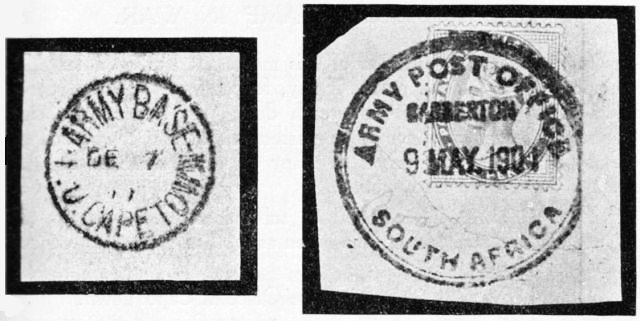 28 29
28 29
[Pg 20] Type 4 (Fig. 28). Used in Base Office at Cape Town.
Type 5 (Fig. 29). A locally made rubber-stamp cancellation found in several sub-varieties.
Type 6 (Fig. 30). Used in the field post offices attached to the Natal Field Force with name of place or number.
Type 7 is similar to type 2 but lettered NATAL FIELD FORCE, found in black and in violet.
Type 8, a newspaper cancellation, with NFF (Natal Field Force) in white letters on a black ground, circular shape.
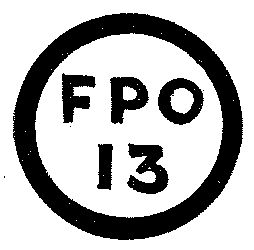 30A
30A
Type 9 (Fig. 30A). A thick lined circle, 20 mm. in diameter, lettered F.P.O. (Field Post Office) and a number, also used for newspapers.
Type 10. An almost circular obliteration lettered P.O.A. (Post Office, Africa) with the number 43, a bracket at each side and two thick bars at top and at bottom.
Type 11 (Fig. 31). Used in travelling post offices (T.P.O.), struck in black or violet. The travelling post offices are "EAST NO. 1," "MIDLAND," "WESTERN," and "NORTHERN."
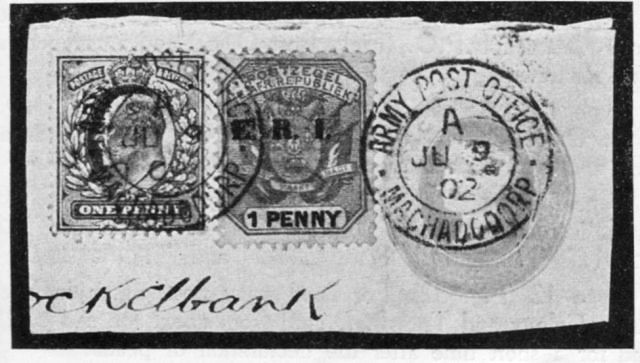 32
32
Type 12 (Fig. 32). For fixed army post offices in Orange River Colony and Transvaal, used from about the end of 1901 and for a short time after the declaration of peace.
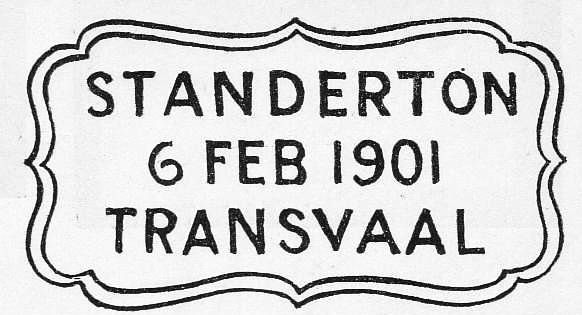 32A.
32A.
A fancy type of town postmark is shown in Fig. 32A.[Pg 21]
Another interesting postmark relic of the war in South Africa is one struck in red "RECOVERED FROM WRECK OF MEXICAN" a ship which was returning from South Africa with mails from the troops, and which foundered after collision with the ss. Winkfield. The bulk of the mail was recovered.
The Great War, 1914. The Army Postal Service with the British Expeditionary Force on the Continent in the present war is under the command of Colonel W. Price, C.M.G., who as Captain Price had the long experience of service with the Army Post Office in South Africa. It is scarcely necessary to say that the volume of correspondence now being dealt with by the service is unprecedented in the history of the British Army. In the early months of the war the outgoing mail to the Army Base Post Office in France averaged 12,000 parcels and 250,000 to 300,000 letters a day. It is impossible to give statistics of the number of branch offices of all grades established, but already there are many interesting postmarks originating with the British Army in France.
The various types of marks so far recorded are:—
Army Base Post Office (Fig. 33).
Advance Base Post Office (Fig. 34).
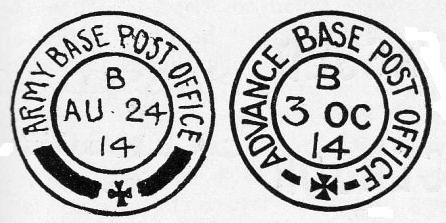 33 34
33 34
Army Post Offices with the Troops (Figs. 35-37).
 35 36 37
35 36 37
There are also a number of types of Censor marks, not all necessarily military, and printed labels used in re-sealing opened letters (Figs. 38-40):
 40. 40A.
40. 40A.
 40B. 40C. 40D.
40B. 40C. 40D.
In this connection may also be mentioned the various marks used on letters sent by prisoners of war in charge of the British military authorities at home and abroad. An old type of prisoner-of-war mark dated 1800 is illustrated in Fig. 41, from "Pre-Victorian Postage Stamps and Franks" by Mr. G. A. Foster.[4]
[4] London. 1910: Charles Nissen & Co.
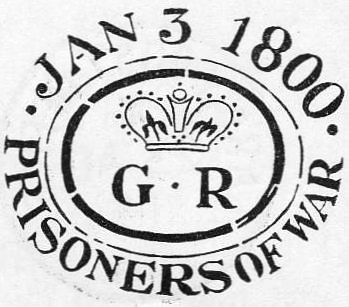 41
41
The following are examples of the marks now being used (Figs. 42, 43):[Pg 23]
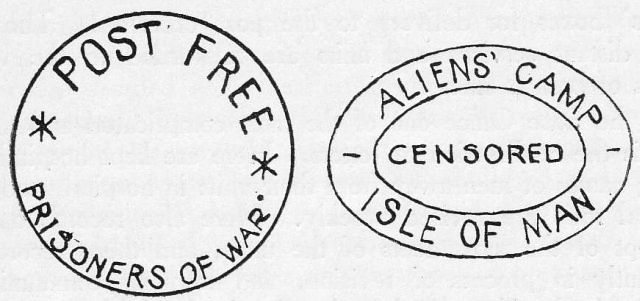 42 43
42 43
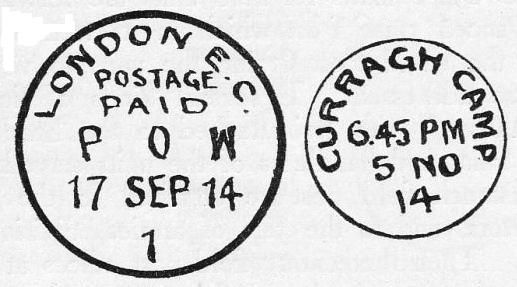 42A. 43A.
42A. 43A.
It may be well to give a brief outline of the methods of the Army Postal Service, that its work may be better known and understood. In addressing letters to the troops it is important to give the full military particulars of the addressee, viz:—Regimental number, rank, name, squadron, battery or company, battalion, regiment (or other unit), staff appointment or department, and title of the Expeditionary Force. With these details set out clearly on the envelope, the work of the Army Postal Service is facilitated and the letter stands every chance of going through without delay.
In France, as the postmarks already illustrated denote, the British Army Postal Service has several grades of post offices. The chief is the Base Post Office, the principal sorting establishment for all mail matter passing between our British Post Office and the Army Postal Service. The Base Office is quite a large concern and has a vast amount of clerical work to perform. In it letters are sorted, letters taking precedence over all other mail matter, after which the newspapers, and lastly the parcels are dealt with. Accounts of all the branch post offices are filed and the general routines and formulae of the Post Office at home are adhered to in detail. Letters, etc., for services, departments and units at the base are put into[Pg 24] callers' boxes for delivery to the post orderlies. Those for more distant services and units are forwarded to the various grades of branch offices.
At the Base Office one of the most complicated and difficult tasks is the re-direction of letters. Here are kept hospital lists, giving names of men away from their units in hospital, and these hospital rolls are revised weekly. Here also records have to be kept of the movements of the units, and these records are constantly in process of revision, and frequent communication is maintained with every branch office in the field.
From the Base Office mails for field units are forwarded to the Advanced Base Post Office, which in its turn distributes them to the Field Post Offices serving the units to which the letters are addressed. There are several kinds of field post offices; those "with train" are attached to the headquarters of each train, and handle the letters of the units served by the train. Branch field post offices are attached to the general headquarters, and to the headquarters of armies, divisions, and brigades. Then there are stationary field post offices at various points on the line of communication, and in some cases travelling post offices on railway lines.
It devolves upon the Director of Army Postal Services, who is represented at general headquarters, and at the headquarters of each Army by an Assistant Director, to organise the service, and to supply to the various offices the information necessary to ensure the proper circulation of the mails. This, especially in a campaign like the present, is a delicate task, often complicated by the restrictions necessary in military policy to preserve secrecy as to the movements of the troops.
Naval Postmarks. Of the naval postal arrangements, reference has already been made to the cancellations used on letters originating with the British Fleet in the Baltic during the Crimean War (Fig. 20). Special navy post offices were in the early days established by local postmasters at various ports as a link between the land service and the Fleet in home waters. The letters were marked with Fig. 44, and the local postmaster collected an extra penny charge upon such letters for delivery to ships lying in the harbour or roadstead.
 44
44
The late Mr. W. G. Hendy, of the Muniment Room, records that with the introduction of Uniform Penny Postage (1840) it was decided so far as Portsmouth was concerned, that such letters should be delivered free in the harbour as far as Spithead; but it was not until May, 1852, that the practice of charging the extra penny for delivery was abolished at Devonport and Plymouth, and free delivery extended to all vessels lying in the harbour (Hamoaze), although not to vessels lying in Plymouth Sound. The following are types of postmarks used after free delivery was granted. (Figs. 45, 46.)
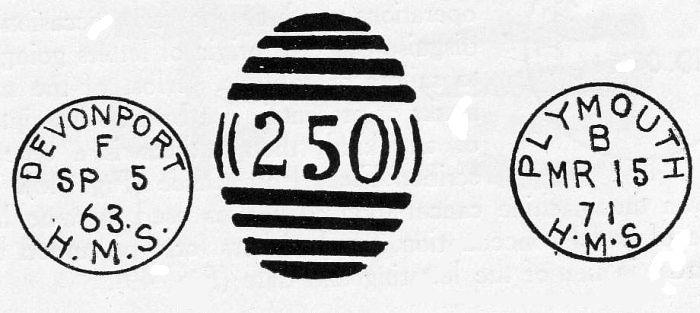 45 46
45 46
The same authority states that a privilege was accorded to non-commissioned officers, seamen, and soldiers of sending and receiving within any part of the British dominions, under certain regulations, letters on their own concerns only, not exceeding half an ounce, at the rate of one penny each. Such letters had to be superscribed with the name of the seaman or soldier, his class and description, the name of the ship or regiment to which he belonged; and if they were the writers of the letters, they had to be countersigned by the officer commanding. When this regulation was not complied with letters were charged as ordinary, and postmarked with Fig. 47.
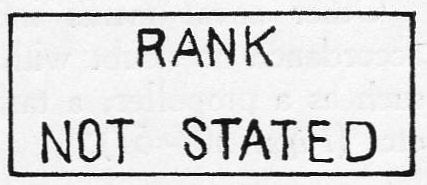 47
47
No doubt there are many more postmarks with a naval interest, including those valued by collectors as indicating stamps on letters originating in the various naval stations abroad from 1858 to 1870, recognised by the following letters and numbers:—
In the present war the naval postmarks promise to be of exceptional interest. The postmarks for both Army and Navy give no clue to the locality in which the correspondence originates; this, of course, applies to mails coming from the field or area of operations; there is no occasion to disguise place of origin of letters going out to sailors or soldiers. Most of the naval marks at present in use bear no inscriptions of any kind, though there is a type inscribed Fleet Post Office (Fig. 48).
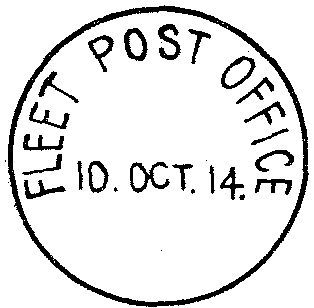 48
48
Even the machine cancellation, doubtless used in some large centre of naval concentration, has had bars (or type turned base upwards) in lieu of the lettering and date (Fig. 49).
 49. Machine Cancellation (Navy).
49. Machine Cancellation (Navy).
Other naval marks introduced in the present campaign, in accordance no doubt with a secret code, are in various devices, such as a propeller, a target, and various arrangements of rings, etc. (Figs. 50-57).
 50 51 52
50 51 52
 53 54 55
53 54 55
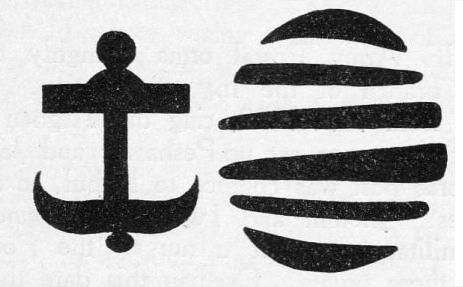 56 57
56 57
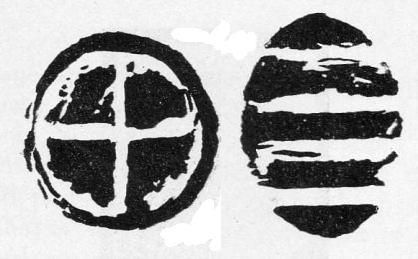 54A. 57A.
54A. 57A.
Indian Army Postal Service — China Expeditionary Force — British Railway Administration in China — Somaliland — The Forbidden City of Lhassa — Indian Expeditionary Force in France.
The Army Postal Service forms a highly organised branch of the Indian Army organisation. It dates from 1878-1880, when, during the Afghan War, a mail cart route was set up between Peshawar and Jellalabad, and a horse post was conducted thence to Kabul, in all about 176 miles. Jhelum and Peshawar were also connected by rail, a military transport train being run by the Post Office between these points. Even earlier than this date there were postal arrangements for Indian Expeditionary Forces, including that operating in Abyssinia (1867-68), the type of postmark being lettered F.F. (Field Force), as in Fig. 58.
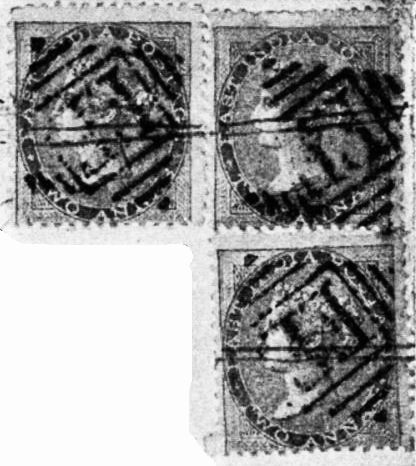 58
58
The postmarks used on letters despatched from troops accompanying the numerous Indian military expeditions form a very considerable range for philatelic exploration. They include Egypt, Miranzi, Kurrum, Hazara, Waziristan, Suakim, Tochi,[Pg 29] Chitral, Malakand, Tirah, China, Tibet, Somaliland, and South Africa. The system of the Indian Army Postal Service is similar to that already described for the British Expeditionary Force on the Continent. A base office is established at each military base, and works as a head office, communicating with India and with the field. Field post offices of 1st and 2nd class are attached to brigades, divisional troops, and divisional headquarters, and these fly a distinguishing flag by day and display a distinguishing lamp by night. The establishment of base and field offices varies according to the size of the force which they are to serve, but ordinarily the establishment of a base office is: 1 postmaster, 2 deputy postmasters, 15 clerks, 2 khalassis, 6 packers, 1 sweeper. First class field post offices are accompanied by 1 postmaster, 2 clerks, 1 packer, 2 tent khalassis, and 1 sweeper, while for second class field post offices the establishment consists only of a postmaster, a packer, and a sweeper. In addition there are supervising officers for each division, and in the event of the post office making its own arrangements for transport between the base and the field offices, a number of overseers are required. The officers and men all have the word "POST" in brass letters on the shoulders of their uniforms.
Postage stamps of India (including postcards and embossed envelopes, both ordinary and "official") are stocked by all field post offices, and ordinarily a six-months' supply is sent out with the force, and is distributed from the base office to the field post offices. It is part of the duty of the base office to see that each field office maintains a sufficient stock of stamps, in accordance with a minimum determined by the chief superintendent in respect of each field post office.
In 1900, in connection with the Boxer Troubles in China, Indian troops were despatched to assist with contingents from all the Powers in the relief of the Legations, and with them went their Army Post Office. Since the settlement of the troubles a permanent Legation Guard has been maintained by the Indian Army in China. On reaching China, the Indian Army Post Office established its base at Hong Kong, but this was temporarily shifted to Wei-hai-wei on account of objections raised by the Postmaster-General of the British colony of Hong Kong. The new base did not prove satisfactory, however, and ultimately Hong Kong became the permanent base, and the[Pg 30] Army Post Office worked in harmonious co-operation with the British Post Office and the Chinese Imperial Post. Field post offices were set up at Pekin, Tientsin, Shanghai, Stonecutters' Island, Wei-hai-wei, Tongshau, Matao, Ching-Wang-Tao, Yangstun, Tongku, Sinho, Hanku, Shan-hai-Kwan, and many other points, sometimes consisting of a couple of tents, but often during this campaign in more substantial structures, and even (according to Mr. Ashley C. Vernieux) in the Temple of Heaven at Pekin.
With the troops sent to China in 1900 the Indian Post Office started the supply of specially overprinted Indian stamps, so that stamps bought in China could not be subject to speculation and sale in India by reason of varying rates of exchange. The Queen Victoria stamps then current, values from 3 pies to 1 rupee were overprinted with the initials C.E.F. (China Expeditionary Force), and the successive issues of Indian stamps have been similarly overprinted for the use of the troops still maintained in China (Figs. 59-61.).
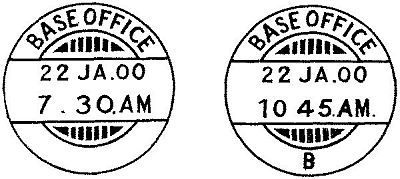 62 63
62 63
The postmarks used on the expedition were Fig. 62 for the[Pg 31] base office, and Fig. 63 for the advanced base, similar marks inscribed at top "FIELD P.O. No. ..." or "F.P.O. No. ..." or single line circular marks inscribed F.P.O. (Figs. 64, 65). There are also a single-line circular date mark of the base office, and registered marks (Fig. 66).
 64 65 66
64 65 66
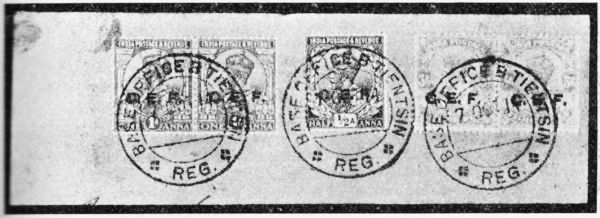 67
67
Fig. 67 illustrates the postmark of the present base post office of the Indian troops in China, located at Tientsin.
On the suppression of the Boxer rising the troops of the Allies were in occupation of Chihli, and the Pekin Shanhaikwan railway was divided up between the English, Japanese, Germans and Russians. By February, 1901, the administration of the whole of the line was in the hands of the British, but it was under the control of a Board consisting of a British director and two deputies, one German and the other Japanese.
At this period the Allies had about 100,000 men in Chihli, but the British troops were stationed at various stations on the line. To facilitate the prompt delivery of the letters of these British troops, the postal superintendent of the British force applied for a sorting van to be attached to the train so that letters could be dealt with en route.... To this application the reply was that no concession could be given to the British which[Pg 32] was not given to all the other forces, and that as the service was then restricted to one train a day, such a concession might result in the train consisting largely of mail vans. But to meet the general convenience, subject to the British postal authorities undertaking to receive and deliver the letters of all nationalities posted at the stations or in a box attached to the van, thus[Pg 33] making the service international, a van was placed at their disposal from April 20, 1901. The new facilities were announced in the circular, of which a facsimile is given (Fig. 68), and the extra fee was collected by surcharging and selling a number of ½ cent Chinese stamps "B.R.A. 5 Five Cents" in black or green (Fig. 69). The B.R.A. stands for British Railway Administration.
DIRECTOR OF RAILWAYS: CIRCULAR No. 15 d/ 15: 4: 1901.
BRITISH RAILWAY ADMINISTRATION.
RAILWAY POSTAL SERVICE.
1.—In order to allow of letters being posted up to the latest possible time, it has been arranged, with effect from the 20th April, 1901, to open post offices at the Railway Stations at Peking, Tientsin, Tongku, Tongshan and Shanhaikwan. These offices will open an hour before the advertised time of departure of the trains carrying the mails and will close ten minutes before the trains leave.
2.—Only ordinary letters will be accepted at these post offices. Registered or insured letters cannot be accepted, nor can newspapers or parcels.
3.—The letters should in all cases have affixed to them the same stamps, or be franked in the same manner, as if they were going through the post in the ordinary way. The Railway Postmaster will therefore accept letters stamped with the stamps of any nationality with post offices now in Northern China, and the stamp will indicate the nationality of the post office to which the letter will have to be handed over for delivery, or further transit, at the end of the railway portion of the journey. Unpaid, underpaid, and unfranked letters will be accepted, but they will he liable to all penalties now existing, and unpaid and unfranked stamps will also run the risk of misdelivery.
4.—The letters must be handed, together with a fee of five cents for each letter, to the Railway Postmaster at any of the stations above named. This five cents is a late letter fee and is in addition to the ordinary postage.
5.—The Railway Postmaster will then affix the Railway stamp, and will retain the letter for posting in the train. The Railway stamp will not be issued to the public to affix themselves, nor will the Railway Postmaster accept any letters with the Railway stamp already affixed.
6.—This service can be used for letters to Europe or any country over sea.
The trains carrying mails leave the stations as detailed below:
| Peking to Tientsin | 8.28 |
| Tientsin to Peking | 12.00 |
| Tientsin to Tongku | 7.20 |
| Tongku to Tientsin | 9.10 |
| Tongku to Tongshan | 9.50 |
| Tongshan to Tongku | 8.30 |
| Tongshan to Shanhaikwan | 7.30 |
| Shanhaikwan to Tongshan | 8.47 |
J. R. L. MACDONALD.
About the same period India had military post offices with the troops engaged on the Swat frontier and against the Waziris. Field Post Office No. 25 was the office at Camp Khar on the Swat Frontier, Nos. 5a and 22 were respectively at Zam and Jani Khel in connection with the blockading of the Mahsud Waziris (Type of Fig. 70).
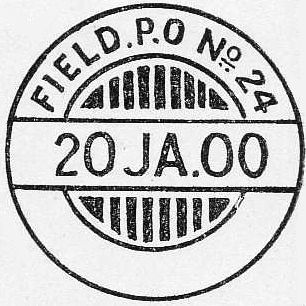 70
70
Indian stamps were also used by the forces engaged in the Somaliland campaign of 1903-4, at first without overprint, of which the following are types of the postmarks (Figs. 71, 72):[Pg 34]
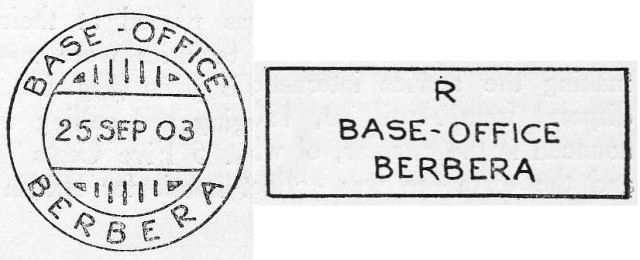 71 72
71 72
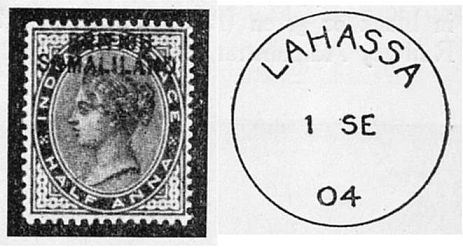 73 74
73 74
and during 1903 stamps of India appeared overprinted for use in British Somaliland (Fig. 73).
Colonel Younghusband's mission to the Tibetan Government was accompanied by army postal service which set up its base in the Chumbi valley, and during the occupation of the forbidden city a field post office was set up at Lhassa. Indian stamps used on this mission are recognisable by the postmarks of Lhassa, including two mis-spellings of the name LAHASSA (Fig. 74), and LAHSSA (Fig. 75).
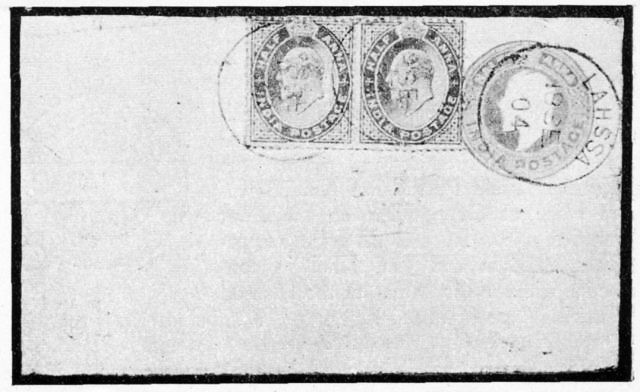 75
75
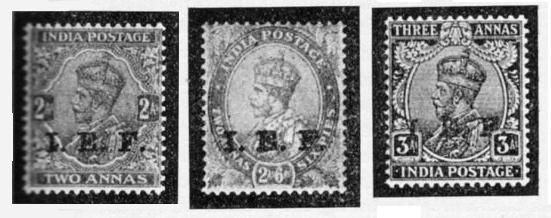 79 80 81
79 80 81
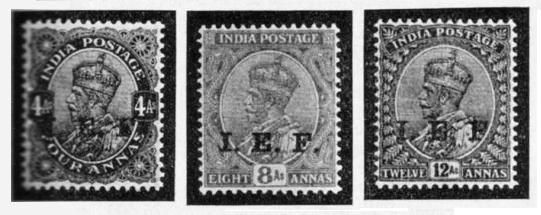 82 83 84
82 83 84
The Indian forces in South Africa also had their own postal establishment, with a special series of postmarks.
In the present campaign the Indian forces are accompanied by fully-equipped field postal arrangements, and following up the precedent of the China Expeditionary Force, the Indian Expeditionary Force in Europe is furnished with a set of current Indian postage stamps, cards, etc., overprinted I.E.F. (Figs. 76-85). The Indian troops enjoy free postage on unregistered letters and postcards posted to the United Kingdom, France, and India, but correspondence to all other countries, such as Switzerland, Holland, Scandinavia, and the rest of the world has to be prepaid with I.E.F. stamps, as also the parcels and registered letters for all countries.
The next figure (85a) illustrates the type of base post office mark used in France, and no doubt similar marks are being used on these stamps supplied to the Indian forces engaged in Egypt and elsewhere during the present war. Fig. 85b although not definitely identified is probably an Indian army postmark in use in France.
The first instalment of the "I.E.F." Indian stamps issued to troops included:
| 3 | pies, | grey (Fig. 76), | 230,400 | stamps. |
| ½ | anna, | green (Fig. 77), | 768,000 | " |
| 1 | anna, | rose-carmine (Fig. 78), | 422,400 | " |
| 2 | annas, | mauve (Fig. 79), | 204,800 | " |
| 2½ | annas, | ultramarine (Fig. 80) | 51,200 | " |
| 3 | " | orange-brown (Fig. 81), | 51,200 | " |
| 4 | " | olive (Fig. 82), | 51,200 | " |
| 8 | " | purple (Fig. 83), | 25,600 | " |
| 12 | " | dull claret (Fig. 84), | 25,600 | " |
| 1 | rupee, | green and brown (Fig. 85), | 9600 | " |
and the following supplies of postcards and envelopes.
| ¼ anna inland postcard, single, | 1800 | reams |
| ¼ anna inland postcard, reply, | 700 | " |
| 1 anna international single postcard, | 100 | " |
| ½ anna envelopes, small size, | 1100 | " |
South African Wars. — Transvaal — Orange River Colony — Krugersdorp — Kuruman — Lydenburg — Mafeking — Pietersburg — Rustenburg — Schweizer Renecke — Volksrust — Vryburg — Wolmaranstad — The Union — South African War of 1914.
Transvaal. The stamps of the Transvaal illustrate the important changes through which the country has passed during the past forty years. Fig. 86 represents an early stamp of the Republic, while the next figure (Fig. 87) is just one example of several denoting the annexation of the country by the British in 1877. There are several types of the "V.R. Transvaal" overprint, as in Figs. 88-90.
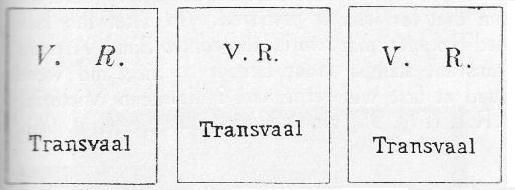 88 89 90
88 89 90
These were followed by stamps bearing the portrait of the British Sovereign (Fig. 91).
A great blow to British prestige was struck in 1881, and the result of the disaster of Majuba Hill was the establishment of a Second Republic which in its turn overprinted the Queen Victoria stamps with a Dutch inscription "Een Penny" (Fig. 92), subsequently returning to the original Arms design of South African Republic stamps (Fig. 86).
 94
94
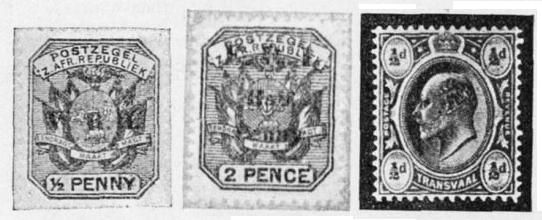 95 96 97
95 96 97
Just before the outbreak of the last South African War in 1899 the ascendancy of President Kruger had led to the ambition to see his features depicted upon the postage stamps of his country, and a new stamp design (Fig. 93) was prepared for this purpose, and a special paper was manufactured watermarked Z.A.R. (Zuid Afrikaansche Republiek) as illustrated in Fig. 94. But the stamp was never issued, and the quantity of the "Z.A.R." paper was sold and used for purposes very different from that for which it was prepared. In 1900, after the late Lord Roberts' march to Pretoria, the contemporary South African Transvaal stamps came under British control again, and were issued at first with the overprinted initials of Queen Victoria, V.R.I. (Fig. 95), and later of King Edward, E.R.I. (Fig. 96). These were superseded in due course by the London printed issue of Transvaal stamps bearing the portrait of King Edward (Fig. 97).[Pg 39]
Orange River Colony. On March 17, 1900, Field Marshal Lord Roberts issued the following
PROCLAMATION.
"Whereas it is deemed expedient and necessary for the welfare of the Orange Free State that the Postal Service shall be resumed in the aforesaid Republic as far as circumstances permit.
"Now therefore,
"I, Frederick Sleigh, Baron Roberts of Khandahar, K.G., G.C.B., G.C.S.I., G.C.I.E., V.C., Field Marshal and Commander-in-Chief of the British Forces in South Africa, do hereby nominate and appoint David George Amosi Falck Administrator of the Civil Posts in such portions of the Orange Free State as have been or may hereafter be occupied by British troops.
"And I do hereby order that the Postal and Telegraph Services shall be resumed in the portions of the aforesaid Republic already referred to, from the nineteenth day of March, 1900, under the existing Laws and Conventions of the Orange Free State, subject to such alterations as may from time to time be notified.
Given under my hand at Bloemfontein this seventeenth day of March, 1900.
GOD SAVE THE QUEEN.
(Signed) ROBERTS,
Field Marshal,
Commander-in-Chief British
Forces in South Africa.
The Administrator shortly afterwards issued the following
NOTICE.
It is hereby notified for general information that Orange Free State postage stamps, in use up to the 14th inst., are no longer valid; surcharged stamps of the same denomination having been substituted.
(Signed) A. FALCK,
Administrator.
General Post Office,
Bloemfontein, March 22nd, 1900.
The stamps of the Orange Free State were successively overprinted "V.R.I." and "E.R.I." (Fig. 98), and later on new stamps were issued with the portrait of King Edward (Fig. 99).
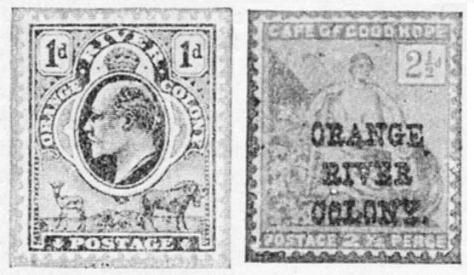 99 100
99 100
Cape of Good Hope stamps were also used in the new Colony with a special overprint reading "Orange River Colony" (Fig. 100).
A sixpence blue stamp of the Orange Free State (type of Fig. 98) was in readiness for issue at Bloemfontein when the British forces took over the control, and a few of these escaped the "V.R.I." overprint. The stamp is familiar to collectors with the overprint, and strictly speaking, without the overprint it has no record of postal use.
A type-set label was issued by the Orange Free State early in the war to indicate the franking of official correspondence probably on military service. The stamp has a border of fancy type ornament and simple type inscriptions in three lines "IN DIENST—R.D.M.—O.V.S."
The so-called "Commando Brief" stamp alleged to have franked the correspondence of burghers on commando is a bogus production.
Krugersdorp. The South African Republic stamps alleged to have been used in this Transvaal town with V.R.I typewritten across them are believed to be purely fictitious creations.
Kuruman. During the siege of this town in British Bechuanaland Cape of Good Hope stamps were overprinted "KURUMAN BESIEGED" and the date, but they are not fully credited by philatelists as bonâ fide issues.
Lydenburg. During the temporary occupation of this South African Republic Town in September, 1900, the stamp commemorative of penny postage (Fig. 101) was surcharged "V.R.I. 1d." and the ordinary Transvaal stamps were locally overprinted "V.R.I." (Fig. 102). The values are ½d. green,[Pg 41] 1d. carmine and green, 2d. brown, 2½d. blue, 3d. on 1d. carmine and green, 4d. sage green and deep green, 6d. lilac and green, 1s. ochre and green.
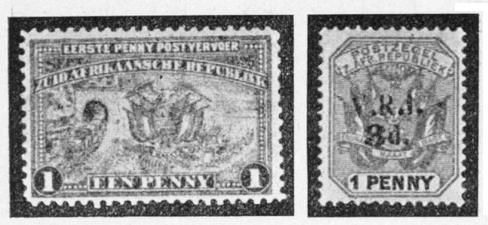 101 102
101 102
Mafeking. During the memorable siege of Mafeking, a Bechuanaland town but under the Cape postal administration, arrangements were made for a local post, and for occasional transmission of letters to Cape Colony, Natal, Rhodesia, and the United Kingdom. The postal arrangements of the town had only been transferred to the Cape Colony shortly before the siege, a fact which explains the variety of Bechuanaland and Cape stamps available in the town during the siege. Payment of postage at the special rates chargeable for the service in the town and beyond was payable in the stamps of either "British Bechuanaland," "Bechuanaland Protectorate," or of the Cape overprinted "Mafeking—Besieged," and the new value (Figs. 103-114). As will be noticed from the illustrations, the Bechuanaland stamps were chiefly created by overprinting the name "BRITISH BECHUANALAND" or "BECHUANALAND PROTECTORATE" on English stamps.
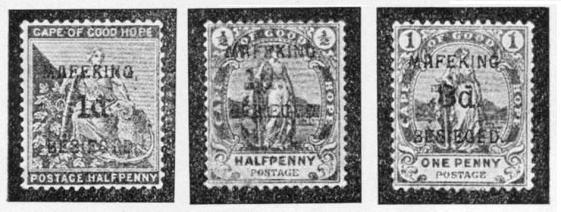 103 104 105
103 104 105
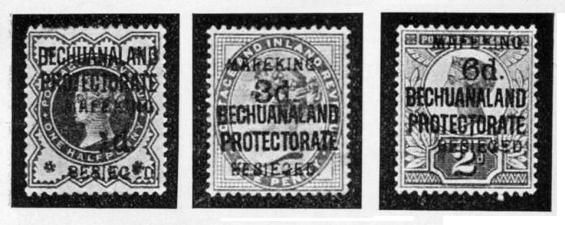 106 107 108
106 107 108
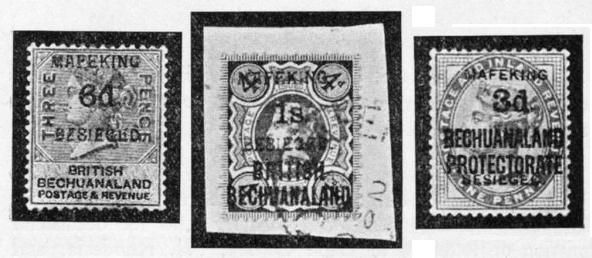 109 110 111
109 110 111
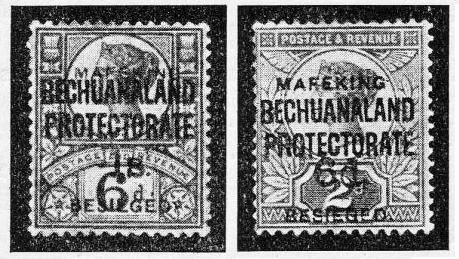 112 113
112 113
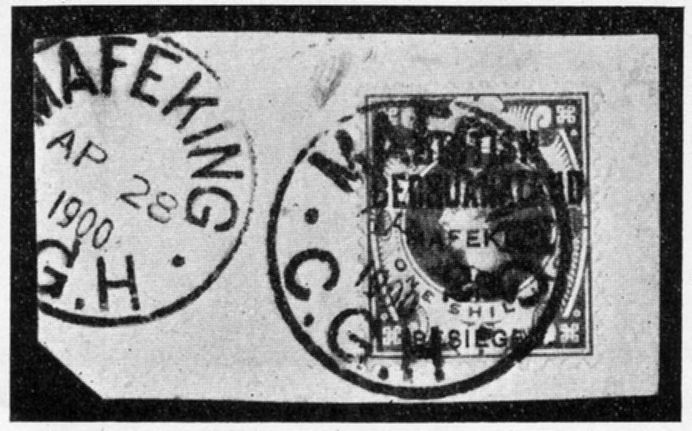 114
114
The foregoing stamps were chiefly used for letters sent by native runners who had to dodge through the enemy's lines and get either to Buluwayo in the north or Kimberley in the south. A special penny and a threepence stamp were prepared by a photographic process in the town, and these form the most interesting philatelic souvenirs of the South African War. The penny stamp, designed by Dr. W. A. Hayes, shows a portrait of Sergeant-Major Goodyear, of the Cadet Corps (Fig. 115), and there are two sizes of threepence stamp, designed by Captain Greener, the Chief Paymaster, showing a portrait of the gallant defender of Mafeking, General Baden Powell.
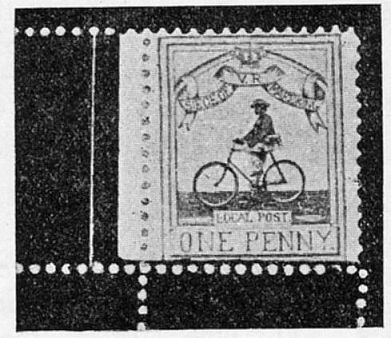 115
115
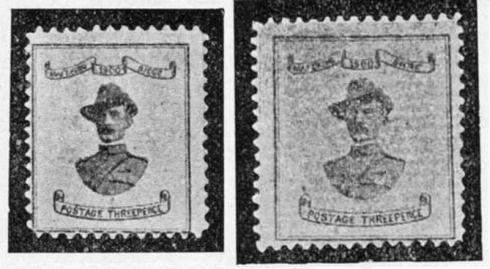 116 117
116 117
Pietersburg. This town in the north of the Transvaal provided an interesting set of type-set provisional stamps during the Boer occupation, from March until April 9, 1901, when[Pg 44] the British troops occupied the town and district. The stamps, which were but roughly printed in the office of De Zoutpansberg Wachter in the town, are inscribed "POSTZEGEL" at top "Z. AFR. REP." at each side, and "1901" at foot. The value is expressed in figures and word in the rectangular opening of the frame of printer's rule (Fig. 118). The values issued were ½d. green, 1d. rose, 2d. orange, 4d. blue, 6d. green, and 1s. yellow, and owing to the crudity of the printing, specialists find a very extensive range of minor technical varieties amongst this issue of six denominations.
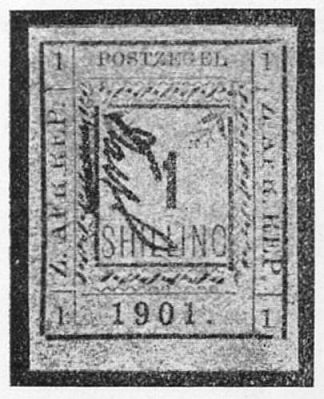 118
118
Rustenburg. After the relief of the British garrison by Baden Powell's force in June, 1900, the British hand-stamped South African Republic stamps with the sans serif initials V.R. in violet, the values known being ½d. green, 1d. carmine and green, 2d. brown and green, 2½d. blue and green, 3d. purple and green, 6d. lilac and green, 1s. ochre and green, 2s. 6d. dull violet and green (Fig. 119).
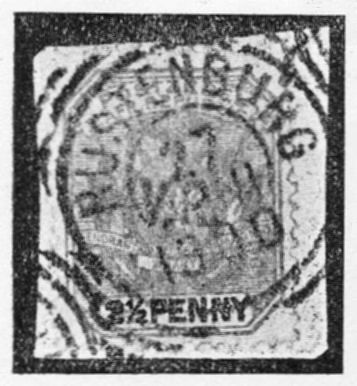 119
119
Schweizer Renecke. This Transvaal hamlet, in which a British force under Colonel Chamier was besieged from August 19, 1900, to January 9, 1901, overprinted some Cape of Good Hope ½d. and 1d. and Transvaal ½d., 1d., 2d., and 6d. stamps with a handstamp, reading "BESIEGED" in violet, but this scarcely alters the postal status of the stamps (Fig. 120).
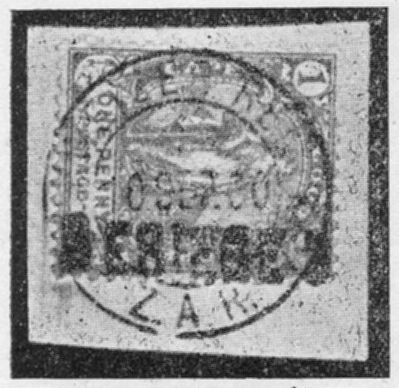 120
120
Volksrust. Here also in June, 1900, a number of Boer stamps were overprinted "V.R.I." in serif letters. The stamps used for the overprinting were fiscal stamps of the type of Fig. 121, converted for postal use by the overprint "POSTZEGEL" (postage stamp) (Fig. 122). The values overprinted V.R.I. were 1d. pale blue, 6d. carmine, 1s. olive-bistre, 1s. 6d. brown, 2s. 6d. purple.
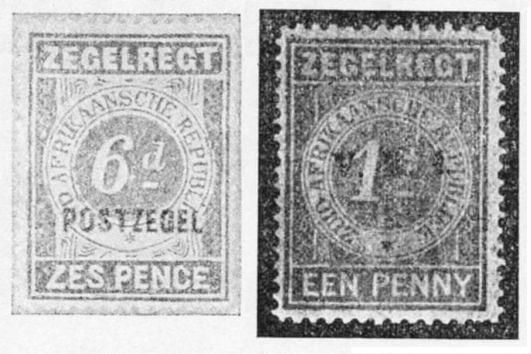 121 122
121 122
Vryburg. In November, 1899, the Boers occupied this town in Griqualand West, and they surcharged some of our Cape Colony stamps in stock there with the initials of the South African Republic (Z.A.R.) and a new value (Figs. 124, 125, 129).
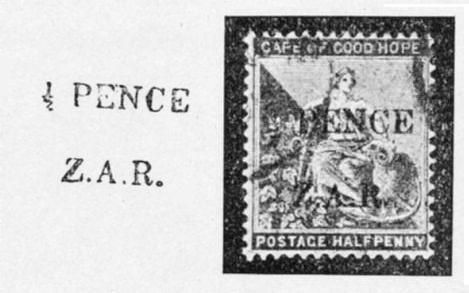 124 125
124 125
The town was retaken by the British in May, 1900, and certain stamps of the South African Republic left behind by the Boers were overprinted with an English inscription (Figs. 126-128).[Pg 46]
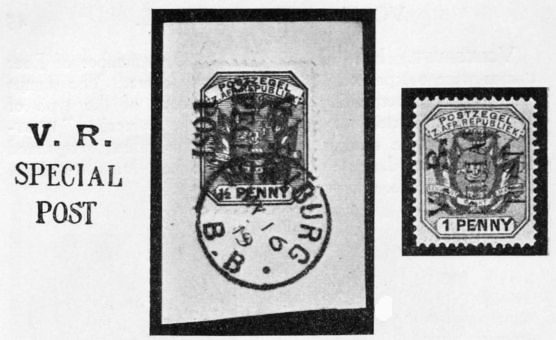 126 127 128
126 127 128
Wolmaranstad. Occupied by the British in June, 1900, the available South African Republic stamps having the Dutch name overprinted "Cancelled" and the addition of the sans serif letters, separated by hyphens "V-R-I." in blue and red. The values are the ½d., 1d., 2d., 2½d., 3d., 4d., 6d., and 1s. of the regular South African stamps, and the 1d. red commemorative stamp, in which, however, the word cancelled is in a square, script type (Figs. 130, 131).
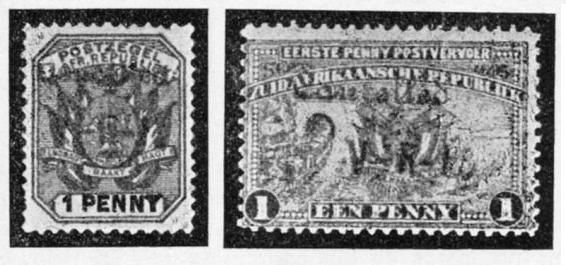 130 131
130 131
Union of South Africa. It was fondly regarded as the settlement of British and Boer troubles in South Africa when the former belligerents in the Transvaal, Free State, Natal, and Cape Colony combined to form the Union of South Africa. The opening of the Union Parliament was commemorated in a special stamp (Fig. 132), the first to bear the portrait of H.M. King George V. after the decease of King Edward.
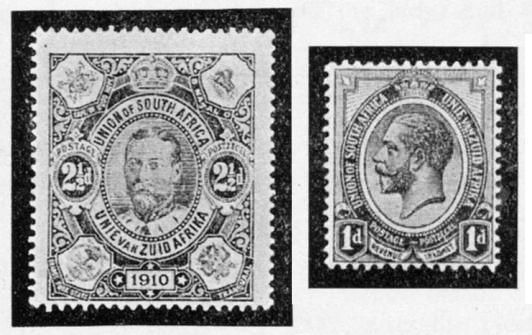 132 133
132 133
This has since been followed with a complete issue of Georgian stamps for the whole of the Union (Fig. 133).[Pg 48]
South Africa in 1914. Already we have a first instalment of special marks used on letters of General Botha's loyal forces against the rebels, and against German raiders. The first (Fig. 134) is the handstamp struck in violet of an official regimental frank. The army base and field post offices have their postmarks of the pattern indicated in Fig. 135, and the censor label illustrated (Fig. 136) is printed in violet, apparently in sheets which before use are endorsed with a black mark of concentric circles bearing an inscription of which only a portion shows on each label, and of which we have only seen an undecipherable part.
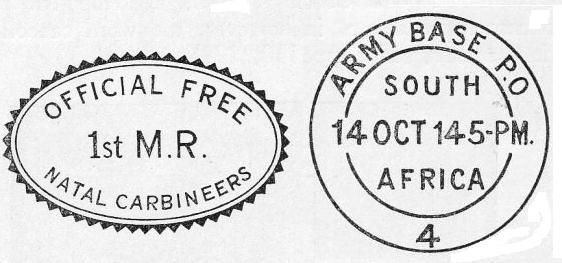 134 135
134 135
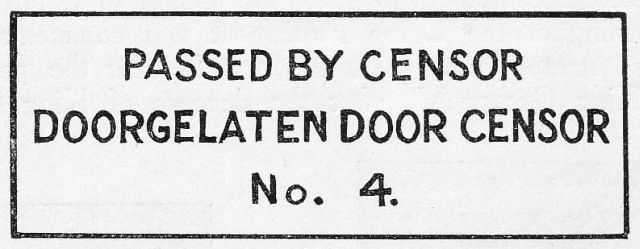 136
136
All three of these were used on a letter from a member of the South African Scottish regiment at Luderitzbucht in German South-West Africa.
France — Napoleon's Minister of Posts — The Second Republic — The Presidency — Empire — French Expeditions to China and Mexico — Sedan — Metz — Strasburg — The Siege of Paris — Balloon Post — Pigeon Post — Peace — Military Frank Stamps — The German Invasion, 1914 — Red Cross Stamps — War Postcards and Postmarks.
The postal arrangements of France have been deranged oft-times within the past century by war and revolution. It is just a century since the famous episode of the Lavalettes occurred. The Count de Lavalette was Director of Posts under Napoleon, and in 1814 he did his best to upset the organisation and fled on the approach of the Allies. The following year he returned to his post, and after Waterloo he was arrested on a treason charge and sentenced to the guillotine. The Countess made desperate efforts to gain the clemency of Louis XVIII., but without avail. In the end she gained permission to go to her husband in his prison. She went in a sedan chair with her daughter, and an old servant of the family. The gaoler left the couple to their last farewell, and on his return saw the broken-hearted wife assisted out by her two companions. A little later he approached the Count, who lay collapsed upon his bed covered in a large cloak, and his face buried in his hands. It was some time after ere the gaoler discovered that his prisoner was the lady, and that the Count had got clear away.
French stamps provide a very interesting record of the political changes in the country, and provide one of the best illustrations of how stamps demarcate the periods of a nation's history. We have dealt at some length with this aspect of French stamps elsewhere,[5] and limit our account here to a short pictorial one. The first French stamps (Fig. 137) are inscribed REPUB. FRANC., and followed in the wake of the revolution of 1848 when M. Etienne Arago was in charge of the post office. They were first issued January 1, 1849, after the election of Prince Louis Napoleon to the Presidency. The head on the stamp[Pg 50] engraved by the elder Barre is not the head of Liberty, as is commonly supposed, but that of Ceres, the Italian goddess of Agriculture, who was the same as the Greek Demeter or "Mother Earth," appropriate for the design of the stamps of a country which is "one of Ceres' chiefest barns for corn." Napoleon's coup d'etat of December, 1851, was followed by the issue in 1852 of stamps in which his portrait takes the place of Ceres (Fig. 138). Late in the same year the Empire was proclaimed, so in 1853 the abbreviated inscription REPUB. FRANC. was altered to EMPIRE FRANC. (Fig. 139). Napoleon's successes in Italy and elsewhere were acclaimed by adding the victor's crown of laurel to the portrait on the stamps in 1863 (Fig. 140). His various expeditions are marked for the collectors in a most interesting range of Army postmarks, used in the Crimea, China, Mexico, etc., and of French stamps used in the French post offices in the Levant, similar to the British ones described in chapter I., and now rendered obsolete by[Pg 51] the closing of the post offices in October, 1914, as a result of the "abolition of the capitulations." The Mexican expedition, largely owing to the Civil War troubles in the States, led to the placing of Emperor Maximilian on the throne of Mexico, and to the issue of stamps of the Mexican Empire bearing that ill-fated ruler's portrait (Fig. 141).
[5] "All About Postage Stamps." By Fred J. Melville. London, 1913. T. Werner Laurie, Ltd.
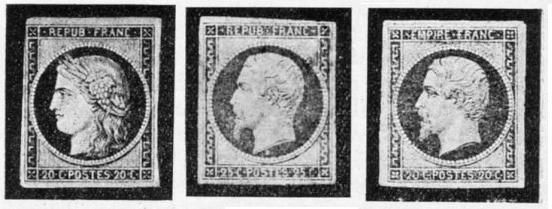 137 138 139
137 138 139
The Franco-German War has left the stamp collector an interesting series of stamps catalogued as Alsace and Lorraine (Fig. 233), but more properly called the stamps of the German Army of Occupation, as they were used in the parts of France occupied by the German Army during the war and afterwards in the two annexed provinces until superseded by the German Imperial issues. September 2, 1870, witnessed the surrender of Napoleon to the Prussians at Sedan, and in November we find the head of Ceres recur on the stamps lithographed at Bordeaux during the siege of Paris (Fig. 142).
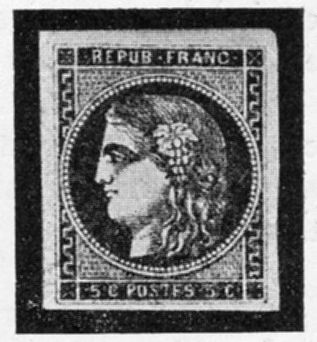 142
142
This period is undoubtedly the most interesting one in modern postal history. There is a vast array of Army postmarks of the war, special postcards issued by the auxiliary committee of the Red Cross at Strasburg, letters sent from Metz during the siege by free balloons, and letters sent by a variety of ingenious methods from Paris. M. Steenackers was the Director of Posts under the republic proclaimed September 4, 1870, and his endeavours to maintain postal communications between Paris and the outer world are among the most fascinating of postal records. A cable was laid under the Seine to Rouen, but the Germans dragged the river and destroyed it. Telegraph wire had to be smuggled into the country, as the Swiss Government declared it to be contraband. Letters were enclosed in different forms of hollow spheres and thrown into the river; the spheres were flanged so that they would rotate with the current. Hundreds of gallant messengers, ladies as well as men, strove to reach the city with concealed messages, mostly without success. One lady is said to have succeeded in getting through with a letter which had been secreted in a hollow tooth and the tooth stopped with gold. Even dogs were sent[Pg 52] with messages to Paris, but most of them were shot by the enemy. The chief means of sending letters out of Paris was the balloon post, and almost the only messages received within the city came by carrier pigeons. There were free balloons and passenger balloons, a higher rate of postage being charged for the latter. Letter sheets, etc., were issued for both services inscribed "PAR BALLON NON-MONTE," or PAR BALLON MONTE. A register was kept of the services of aeronauts during the siege.
The messages sent by pigeons were at first written in very small handwriting, but afterwards they were photographed in microscopical minuteness, so that a very large number could be carried by one pigeon. These photomicrographs were projected on to a screen by means of an optical lantern to read and transcribe the messages when received in Paris. The films were placed in tubes attached to the pigeon's tail. One pigeon arriving in Paris January 28, 1871, delivered 40,400 messages by this means.
The later and more peaceful history of France has been typified on its stamps by M. Jules Sage's allegory (Fig. 143) representing Peace clasping hands with Commerce across the world by means of the post, and by the late M. Roty's pleasing Semeuse or Sower design (Fig. 144).
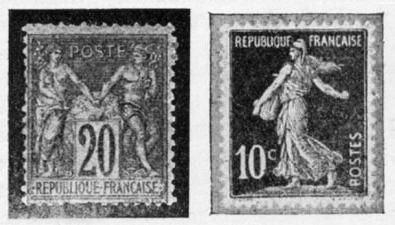 143 144
143 144
By a law promulgated February 9, 1900, a long discussed project to allow soldiers and sailors serving with the colours a limited free postage was brought into operation. Each man coming under the description was allowed to send two letters a month free, and by another law of December 29, 1900, the Franchise Militaire stamp system was introduced. These were[Pg 53] at first the then current 15 centimes stamps with the overprint F.M. (Fig. 145); their distribution is in the hands of the military authorities, who allow two stamps a month to each private or non-commissioned officer in the Army and Navy, enabling them to send two letters not exceeding 20gr. free of postage. The two types of the 15 centimes "Rights of Man" issue exist with the F.M. overprint, issued in 1901 and 1903 respectively (Figs. 145, 146), and the succeeding Sower type (Fig. 147) appeared in 1904. When the French inland postage rate was reduced from 15 centimes to 10 centimes, April 16, 1906, the 10 centimes stamps were overprinted F.M. instead of the 15 centimes, two of the Sower types of 10 centimes value receiving the overprint F.M. respectively in 1906 and 1907 (Figs. 148, 149). Since January 30, 1912, these stamps have been used on the official correspondence of the French civil service as well as by the military.
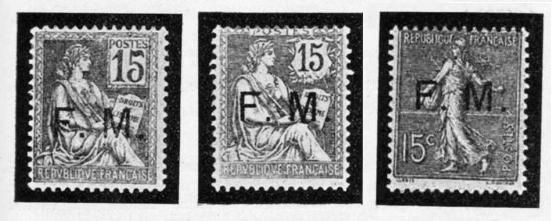 145 146 147
145 146 147
After forty years the fair fields of France are once again ravaged by the German invaders, and already our allies across[Pg 54] the channel have issued special stamps which serve the double purpose of denoting postage and of collecting small contributions to the French Red Cross. The following is the official decree:
Le Président de la République Française.
Sur le rapport du Ministre du Commerce, de l'Industrie, des Postes et des Télégraphes,
Décrète:
Article premier.—Il est créé un timbre-poste spécial, dénommé "Timbre de la Croix-Rouge Française." Le public aura la faculté, dans le régime interieur seulement, d'utiliser ce timbre qui vaudra affranchissement jusqu'à concurrence de 10 centimes seulement.
Art. 2.—Ce timbre-poste est vendu 15 centimes. La différence entre le prix de vente et le valeur d'affranchissement, déduction faite de la remise réglementaire de 1p. 100, sera versée à la Commission institutée par le décret du 8 août, 1914, au ministère de la Guerre, sous l'autorité du service de santé militaire et avec le concours des Sociétés formant la Croix-Rouge française.
Art. 3.—Par mesure transitoire et en attendant l'impression du nouveau timbre, le public aura à sa disposition des timbres-poste ordinaires à 10 centimes, portant en surcharge le signe de la Croix-Rouge et le chiffre 5.
Art. 4.—Le ministre du Commerce et le ministre des Finances sont chargés, chacun en ce qui le concerne, de l'execution du présent décret.
Fait à Paris, le 11 août, 1914.
R. Poincare.
Par le Président de la République:
Le Ministre du Commerce, de l'Industrie, des Postes et des Télégraphes,
Gaston Thomson,
Le Ministre des Finances,
J. Noulens.
As indicated in the decree, the first stamp (Fig. 150) was only of provisional character, the ordinary French 10 centimes stamp being surcharged "+ 5c", and selling for 15 centimes, two-thirds representing the postage, and one-third the Red Cross contribution. This was issued on August 18, 1914, and in all 600,000 were printed before the definite Red Cross stamp (Fig. 151) was issued on September 10. The Principality of Monaco has also issued a similarly overprinted stamp for the French Red Cross (Fig. 152), and yet another of this class of stamp has been issued for the French Protectorate in Morocco (Fig. 153).
Special postcards have been furnished to the French troops and there is a special postcard for the use of the public in writing to soldiers. They are decorated with the flags of the Allies in colours, and the first kind, "Modèle A," bear instructions to the effect that "This card must be handed to the Quartermaster. It must bear no indication of the place[Pg 56] of sending nor any information relating to military operations, past or future. Otherwise it will not be forwarded."
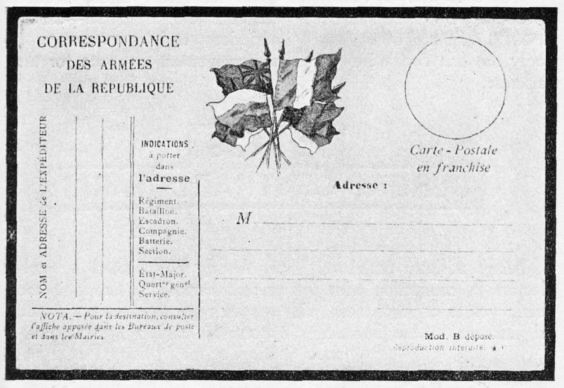 154
154
On "Modèle B" (Fig. 154), for the use of the public, it is stated that "if it is to be forwarded immediately the card shall contain personal news only." Messrs. Alfred Smith & Sons report the existence of an unofficial imitation of "Modèle B" sold in the streets of Paris. It differs from the genuine variety in the following details:
There is also a variety of plain letterpress cards, headed "CORRESPONDANCE MILITAIRE—REPUBLIQUE FRANCAISE—CARTE POSTALE", and other textual inscriptions, or in some cases with only the first two words, with an arrangement of space for the address.
Many military postmarks have already been noted by collectors in connection with the present campaign, but it is too early yet to arrange them with proper regard to their use and significance. One interesting episode is marked by the postmark of the Central Military Postal administration of Paris (Figs. 155, 156). This establishment accompanied the French Government when the latter moved to Bordeaux on September 3, and continued to use the postmark inscribed Paris there, so that impressions of Fig. 155 bearing dates between September 3 and October 13 (the date of the return to Paris) originated not in Paris, but in Bordeaux.
 157 158 159
157 158 159
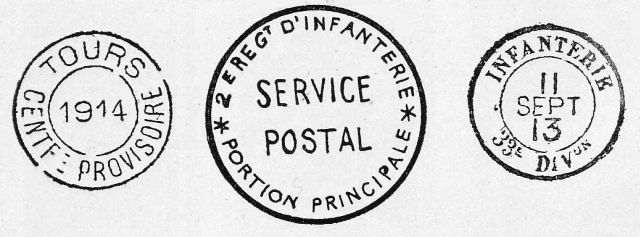 160 161 162
160 161 162
A somewhat pathetic interest attaches to the mark Fig. 157 indicating "LIEU DE DESTINATION ENVAHI" (place of destination invaded), and it appears that Tours has been a temporary centre for civil correspondence undeliverable to parts of the country which have been invaded (Figs. 158-160).
Figs. 161-168 represent various types of army postmarks, regimental franks, etc., being used during the present campaign.
 167
167
 168 163
168 163
 164 165 166
164 165 166
Russia — War Charity Stamps — Portraits of the Tsars — War Stamps of 1914 — Japan — War with China — The Empress Jingo — Triumphal Military and Naval Reviews — Kiao-chow— Belgium — King Albert — Bombardment of Malines — Private Postal Service — Germanised Posts — Red Cross Stamps — Bogus Stamps — Postmarks — Serbia — "Death Mask" Stamps — King Peter — Montenegro — King Nicholas.
Russia. The Empire of the Tsars has provided collectors with a few stamps of philanthropic interest in connection with its wars. A set of four denominations was issued in 1905 and sold at 3 kopecs per stamp in excess of the face-value, this extra sum going to the fund organised by the Imperial Women's Patriotic Union for the benefit of orphans of soldiers and sailors who fell in the war with Japan. The following are the descriptions of the stamps which were printed by the Imperial Printing Office at St. Petersburg in the delicate colour work for which that establishment is justly celebrated; the figure in brackets denotes the price, in kopecs, charged for each, including the 3 kopecs charity contribution (Figs. 167-170):
| 3 | (6) | kopecs, | red-brown, cerise, and yellow-green. |
| 5 | (8) | " | violet, red-lilac, and buff. |
| 7 | (10) | " | dark blue, pale blue, and rose. |
| 10 | (13) | " | dark blue, pale blue, and orange. |
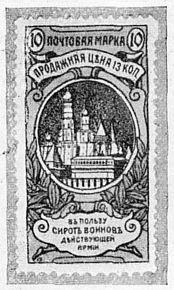 170
170
Normally the stamps are perforated 12 × 12½, but the 3 (6) kopecs exists perforated 13, 13½; 11½; and a compound of these two measures. The 7 (10) and 10 (13) kopecs also exist perforated 13, 13½. The stamps appear to have been designed[Pg 60] by Richard Sarring, an artist attached to the great printing works of the Russian Government. The subjects represented are—
| 3 | kopecs. | Monument of Admiral Nachimoff at Sebastopol, a hero who was wounded in the Crimean War. |
| 5 | " | Monument to two national heroes of the Tartar dominion, Minin and Pascharski. |
| 7 | " | Statue of Peter the Great. |
| 10 | " | The Kremlin, with statue of Alexander II. in the foreground. |
The small doles of 3 kopecs per stamp collected in this manner for the orphans' fund yielded about 50,000 roubles, roughly £5600.
The portraits of the Tsars never appeared on the stamps of Russia until 1913, when a very fine portrait and view series of stamps were issued (Figs. 171-187), and although not issued as war stamps they are full of reminiscence of the three centuries of the stirring history of the Romanofs.
The set begins with a picture of Peter the Great, after a portrait by the Dutch painter De Moor, on the 1 kopec stamp. There is another portrait of Peter on the 4 kopecs stamp, this one being copied from an engraving of the picture painted by Kneller to the order of King William III., and now at Hampton Court. Czar Alexander II. figures on the green 2 kopecs stamp, and Alexander III. is portrayed on the 3 kopecs. The present Czar, Nicholas II., appears on the 7 kopecs brown, the 10 kopecs blue, and the highest value in the set, viz., the 5 roubles (1 rouble = 2s. 1½d.). A portrait of Catherine II., after the painter Skorodoñmow, and another of Elizabeth II. after Tchemesow, add two more to the list of illustrious females in the stamp collectors' portrait gallery. These are on the 14 kopecs green and 50 kopecs brown, respectively. The other Czars depicted are Nicholas I. (15 kopecs), Alexander I. (20 kopecs), Alexei Michaelovitch (25 kopecs), Paul I. (35 kopecs), and last, but actually the first and founder of the dynasty, Michael Feodorowitch (70 kopecs).
On three of the rouble values are views which include The Kremlin at Moscow (1 rouble), the Winter Palace at St. Petersburg (2 roubles), and the Romanof House (3 roubles).[Pg 61]
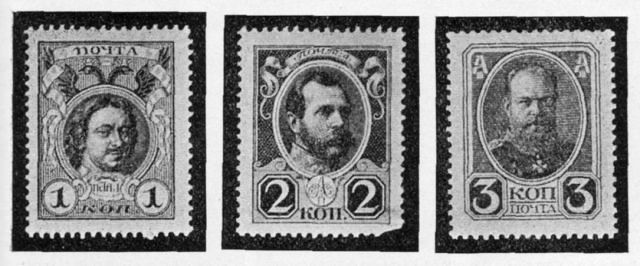 174 175 176
174 175 176
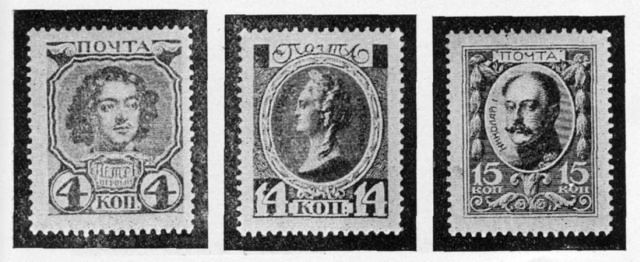 177 178 179
177 178 179
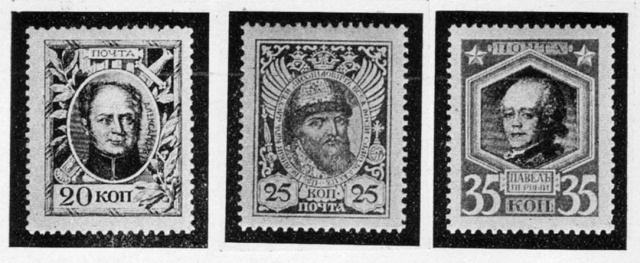 180 181 182
180 181 182
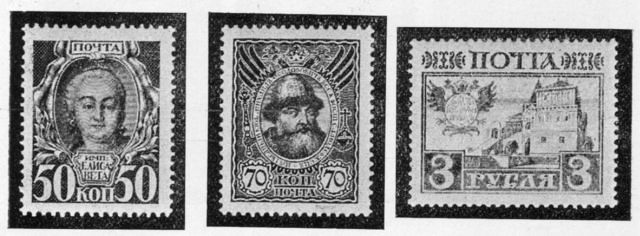 183 184 185
183 184 185
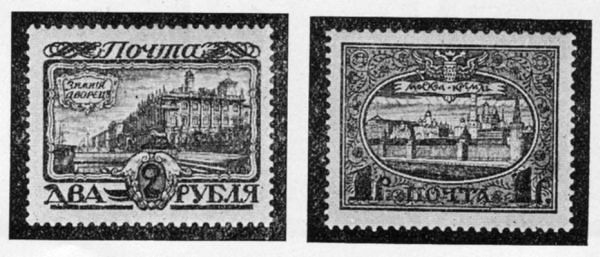 186 187
186 187
Early in the course of the present war the Russians invaded East Prussia, and it is reported that they were using Russian stamps in that country, but up to the time of writing, examples have not come to hand. The only special marks yet noted in this country from Russia are various censor marks and labels (Fig. 188).
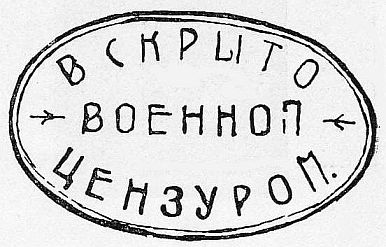 188
188
In this war philatelic history is repeating itself, for Russia has issued a new set of war charity postage stamps (Figs. 189-192) for a fund organised by the Imperial Women's Patriotic Union, of the face values 1 kopec, 3, 7 and 10 kopecs, each of which sells for one kopec more than the franking value denoted. The extra kopec goes to the fund, which is to relieve distress among widows and orphans of soldiers and sailors killed in the war (see Frontispiece).
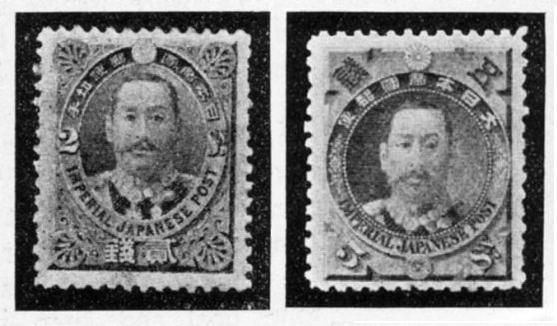 193 194
193 194
Japan. The rapid modern rise of our Far Eastern Ally to power is marked upon a few interesting stamps of a commemorative character. Japan's successful war against China (1894-95) was commemorated by an issue of four stamps in 1896. These are of two denominations, each of which is in two varieties, an outcome of an Eastern etiquette which at a later date was evinced in the stamps of the Republic of China. The Japanese stamps in question portray two heroes of the war; the denominations were 2 sen and 5 sen, but that there should be no suggestion of any inequality in their admiration for the two heroes, the Japanese postal authorities had two stamps of each[Pg 64] denomination prepared so that each warrior figured on a 2 sen and also a 5 sen stamp. Thus neither could be regarded as being valued higher than the other, and neither could be said to be given greater prominence. One of the portraits (Figs. 193, 194) is that of the late Marshall, Prince Arisugawa Taruhito, chief of the staff of the Army of the Japanese Empire, and the other (Figs. 195, 196) is the late Lieutenant General Prince Kitashirakawa, Commander of the Imperial Guards engaged in the subjugation of Formosa.
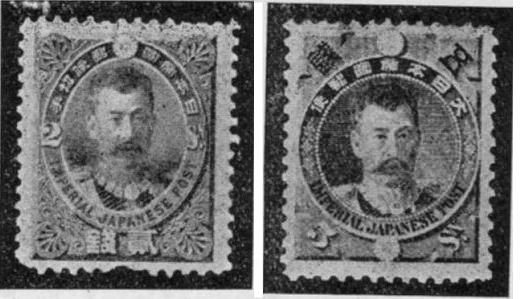 195 196
195 196
At a later date, 1901, there was a proposal to commemorate the services of the late Lieutenant General, and a 3 sen stamp was announced; its design was to comprise the imperial crest (the chrysanthemum) and a Formosan Shinto Shrine. The stamps were heralded as about to be issued in time for the festival of the Shrine celebrated at Taipeh on October 27 and 28, 1901.
In 1905, as the outcome of Japanese military successes in the East against China and Russia, full administrative control was taken over Corea, and a special stamp of the value 3 sen was issued to mark the amalgamation of the Japanese and Corean postal services.
Yet another pair of stamps commemorates somewhat ancient history; they were issued in 1908 and bear the portrait of the Empress Jingo-Kôgô (Fig. 197), who is stated to have been Regent from 201 to 269 in lieu of her son Ojin. She waged a victorious war against Corea. The legend goes that the god Sumiyoshi acting as pilot for her on the sea, caused gigantic fishes to surround the boat and keep it afloat when a great storm threatened to send the ship to the bottom.
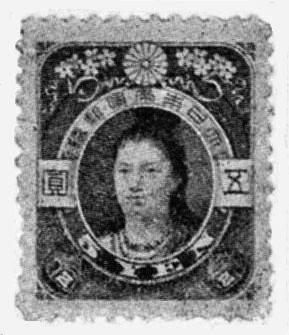 197
197
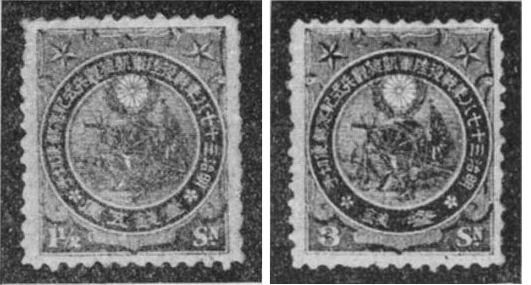 198 199
198 199
The next two stamps (Figs. 198, 199) were issued on April 30, 1906, to mark, according to the inscriptions the "Campaign of the 37th and 38th years of Meiji. Memorial Postage Stamp of the Triumphal Military Review—One Sen five Rin" (or, for the higher value—Three Sen). In the centre is a trophy of arms, including a field gun, rifles, and ammunition, and the Imperial flag, the Crest or Chrysanthemum, within a wreath of rice plant and pine. In the spandrels are the five-pointed stars, badges worn by the Japanese soldiers.
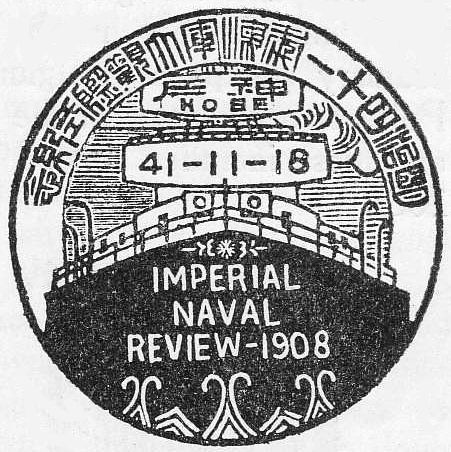 200
200
Two years later a great naval review was held at Kobe, and although no special adhesive stamp was issued, a quaint postmark representing the bow of a battleship was used (Fig. 200).
The stamps already mentioned under Japan have only a commemorative association with war. In 1910 the 3 sen carmine stamp then current was specially overprinted with Japanese characters (Fig. 201), signifying war or field service. These were prepared for[Pg 66] and issued to the Japanese military and naval forces in China and Corea, and it is very probable that the Japanese forces recently co-operating with the British at Kiaochow used stamps of this kind, but with the overprint on the new 3 sen stamp illustrated (Fig. 202).
Belgium. Brave little Belgium, whose King is the outstanding hero of the present war has not hitherto had any occasion to provide collectors with war stamps since the first Belgian issue of adhesive postage stamps in 1849-50 with the portrait of Leopold I. (Figs. 203, 204). But the German invasion, and the gallant efforts to frustrate it, have left their mark imperishably in the stamp album. The last current ordinary stamps of Belgium were in four designs by M. Ed. Pellens, a professor at the Antwerp Académie des Beaux Arts, and these included a good portrait of King Albert (Figs. 205-208).
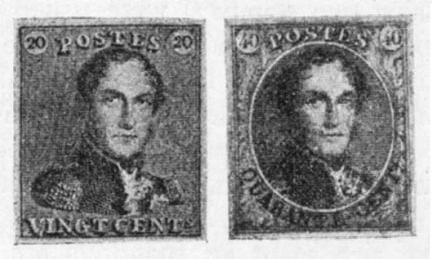 203 204
203 204
These stamps were manufactured at the Belgian State Stamp-printing factory at Malines, and as the factory was destroyed in the bombardment of the town late in August, it is unlikely that more of these stamps will be printed. The Belgian authorities[Pg 67] had been preparing a new issue of stamps before the war, and had ordered machinery in England, which at the time of writing is not delivered, but which will probably be delivered to the Government at Havre, where temporary arrangements will be made to supply Belgian stamps to the inhabitants of the small part of the country not in the hands of the enemy, and incidentally to be ready to reorganise the Belgian postal system as the Germans get driven further and further back to their own country.
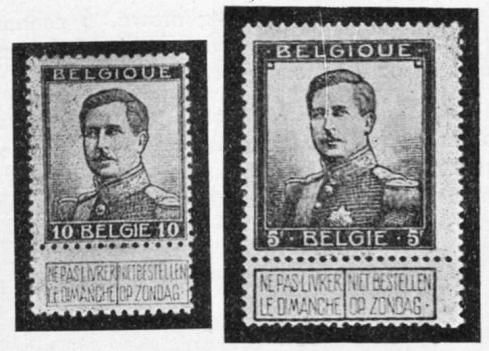 207 208
207 208
Early in September, 1914, it was reported that a private postal service was working between Ostend and Blankenberghe, and Brussels, Namur and Nivelles at a charge of 1 franc per letter, but no information is yet to hand of any special stamps or postmarks being used in connection with the service.
The Germans have conducted the posts in Belgium with a view to the requirements of their own countrymen in the temporarily conquered land, and incidentally to make profit out of the Belgians and out of philatelists. There will no doubt be many interesting curiosities in the postmark line arising from the Germanisation of the names on the cancelling cachets, such as Lowen (Louvain), Lüttich (Liège), Kales (Ostend), etc. But the chief philatelic interest attaches to the issue of special stamps, or rather the ordinary German stamps, overprinted in Gothic type "Belgien", and with the currency surcharged in centimes (Fig. 209). Of these there are four[Pg 68] denominations, 3 centimes on 3 pfennig brown, 5 centimes on 5 pfennig green, 10 centimes on 10 pfennig red, and 25 centimes on 20 pfennig blue.
The Belgian Government authorised the preparation of stamps for collecting funds for the Red Cross, and these made their appearance on October 3, 1914. There are two sets of three values—5, 10 and 20 centimes. The set in the smaller size portrays King Albert (Figs. 210, 211), and the larger size stamps bear a picture of a monument commemorating the Belgian War of Independence, 1830 (Figs. 212, 213).
The Belgian Red Cross stamps were for some time rather difficult to obtain, as it appears that the stock was left behind at post offices to which the Belgian authorities have not had access since their removal to Havre. Undoubtedly vast numbers of these stamps could have been sold in England and elsewhere had they been procurable from Belgian sources.[Pg 69]
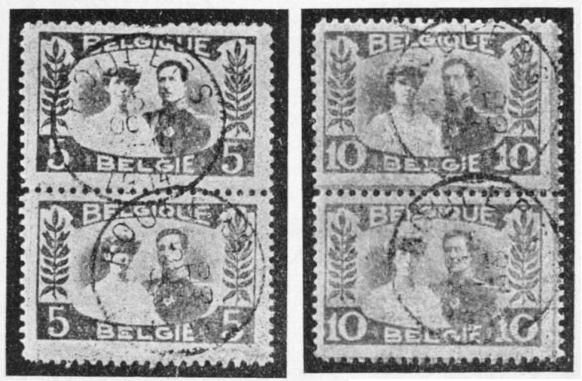 214 215
214 215
The interest aroused in the Belgian Red Cross stamps, and the difficulty in obtaining them, has probably been responsible for the attempt to exploit collectors with a set of three labels purporting to be "new Belgian stamps, sold in Flanders only during two days. The emission was very small, only 15,000 series, which were paid the double of the nominal value, i.e., 70 centimes." The "stamps" are figured 5 (green), 10 (red) and 25 (blue), but no "c" or centimes. They bear within a fancy frame lettered BELGIQUE at top and BELGIE below portraits of King Albert and his Consort (Figs. 214, 215). Messrs. Alfred Smith & Son submitted these "stamps" to the Belgian postal administration, and were told that not only are they not official stamps, but that "they have apparently been obliterated with a stolen or forged date-stamp." The "postmark" reads ROULERS—5 OCTO—18-19—1914.
The Belgian Government moved to Havre in France on October 13, 1914, and there they have a special post office using the postmark Fig. 216. The headquarters of the habitations of the Belgian Government are reckoned part of Belgium, and while the Belgians may send letters to their different addresses in Havre or to Belgium, for the unit rate of 10 centimes (1d.), letters for France, even for another part of Havre, are treated as foreign letters, and require to be prepaid at the 25 centimes (2½d.) rate.[Pg 70]
There are also Belgian military postcards at present in use by the soldiers, and a variety of military postmarks, of which Fig. 217 is an example.
An interesting trio of covers has been received from a young marine who was with the Naval Brigade at Antwerp. The first, dated October 6, 1914, has the postmark (Fig. 218).
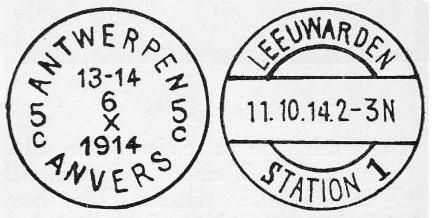 218 220
218 220
On the 11th he was evidently interned in Leeuwarden (Fig. 220) Holland, his letter being censored (Fig. 39). On the 27th he wrote from Groningen, where most of the naval brigade men were interned. The letter has the Groningen machine cancellation, and Fig. 221 struck in violet:
 221
221
Serbia. Revolutionary disturbances have assisted the changes of the stamps of Serbia. Michael Obrenovich III., who figures on the issue of 1866, was assassinated on June 10th, 1868, by the friends of the abdicated prince, Alexander Karageorgevich. Milan IV., his successor, had a troublous reign; during his period the country was recognised as a kingdom with Milan as king, but he abdicated in 1889 in favour of Alexander, his son. The portraits of Milan and Alexander figure on the stamps of their respective reigns, and in the case of Alexander we get one of those philatelic issues which must imprint on our minds the memory of notable or notorious events. It is within the memory of most of our readers that Alexander and his consort, Queen Draga, were assassinated by a number of military officers in 1903, and the house of Karageorgevich once again ruled in Serbia in King Peter, the present monarch. At the time of the assassination a new series of stamps bearing the portrait of Alexander was in readiness for issue, but before they were sent out under the new regime the effigy of the murdered king was almost completely obliterated by the overprinting of a design of the Serbian Arms (Fig. 222).
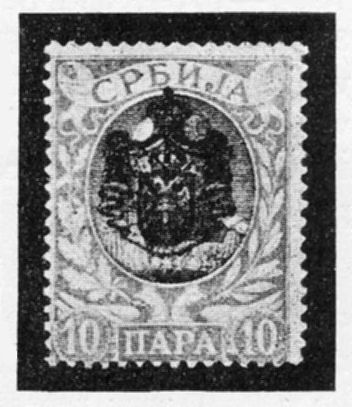 222
222
The year following the grimmest of all the royal tragedies of Serbia the surviving dynasty commemorated its centenary, and issued perhaps the most sensational stamp series known to collectors. These will go down to posterity as the "Death Mask" stamps, although the curiosity of artistry which led to this designation probably owes more to the excited imagination[Pg 72] of the Serbian and foreign public than to any gruesome intent on the part of revolutionary artists.
The Coronation stamps of King Peter, issued September 21, 1904, are of large size, and in two designs, by G. Janovic. M. Mouchon was the engraver, and the stamps were printed at the French Government Stamp Printing Factory in Paris. The names of the designer and engraver appear in microscopic letters below the design of each stamp. The first design (Fig. 223) shows a medal on which the profile of the new King Peter is superimposed upon the profile of the founder of the dynasty "Kara," or Black George. The names inscribed upon the medal are KARA GJORGJE at left, and PETAR I. at right. To the left and right of the medal respectively are the centennial dates 1804-1904, and below are the Serbian Arms, with the motto SPES MIHI PRIMA DEUS. Along the top of the stamp in Sclavonic characters is KRALJEVINA SRBIJA (Kingdom of Servia), the value in PARA is in the lower left corner, and the word POSHTA in the lower right corner. This design was used for all the para values.
For the higher values in dinar (Fig. 224), the same frame design is used, but for the medallion what may have been the reverse of a Coronation medal is shown. This is reputed to be an allegory representing the successes of the guerilla leader Kara-George, founder of the dynasty against the Turks in 1804. There is a minute inscription on the medallion below the picture signifying THE DAWN OF LIBERTY, 1804.
These stamps were at first received by collectors with disdain and some disgust; the memory of the tragedy of June 10th, 1903, was still too fresh to allow the world to join readily in any jubilation over the centenary of a dynasty which had been dragged from obscurity after many years, to occupy a throne lately emptied by the foul hands of assassins. It is even said that the early sales of the stamps were entirely disappointing. But this was all changed from the moment rumours of a cunning intrigue attached themselves to the issue.
It is probably—almost certainly—an accidental effect produced by the drawing or engraving of the two heads, one over the other, that they produce in more ways than one, other composite "faces." By masking the lower part of the profile of Kara George it is possible to distinguish a new face with an ugly gashed brow; but the alleged "Death Mask" of[Pg 73] Alexander is seen by turning the stamp upside down, and regarding that portion of the inverted profiles which may be marked off in triangle fashion with the chins as the base of the triangle. There is certainly a curious and hideous effect, but similar, if less ghastly, artistic curiosities occur in numbers of other stamps, and in many other forms of pictorial representation, and in the case of the Serbian Coronation issue it is probably pure accident. Fig. 225 represents the current type of Serbian stamp, with a military portrait of King Peter.
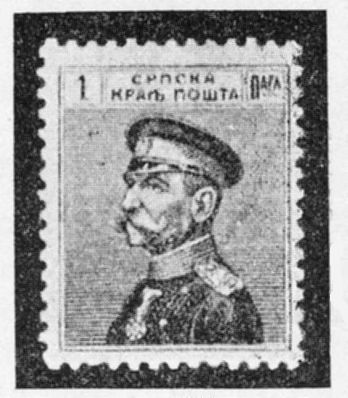 225
225
Montenegro. Tsar Nicholas of Montenegro has not given us any special war stamps, but the warrior King's portraits, at various stages in his career appear on the stamps issued in 1910 for his jubilee. The 1 para shows him as he was during his student days in Paris (Fig. 226), the 2 and 20 paras show him with his bride at the date of their marriage, 1860 (Fig. 227). The other values show various portraits of the King, including one of him on a charger leading his troops to battle (Fig. 228).
Germany. In postal arrangements for armies in the field Germany has shown earlier organised war posts than any of our Allies. As with the regular postal systems on the Continent, their early history is bound up with the records of the princely house of Thurn and Taxis, of which house Count Roger set up in 1460 the first horse post between the Tyrol and Italy. About 1535 Johann Baptista von Taxis created the first field post offices operating with the armies of the Emperor Charles V. against the Turks and in Italy. The hereditary monopoly which the Thurn and Taxis family enjoyed from the fifteenth century continued well into the nineteenth, the last remnant of it being purchased from the family by Prussia in 1867 for three million thalers.
The growth of Prussian dominion and the fusion of the German States into one vast empire is well demonstrated in the stamp album by the joint Austro-Prussian issues for the conquered Danish duchies, by the disappearance of the States from the list of separate stamp issuing countries, replaced at first by stamps of the North German Confederation, and later by stamps of the German Empire.
The stamp collection plainly shows the modern progress of military Prussia to the lead in the Germanic countries. Collectors have many interesting postal relics of the Austro-Prussian War of 1866 in the form of Feldpost Brief, and the Franco-Prussian War brought about the first special war stamps issued by Germany for the use of their armies of occupation in Alsace and Lorraine, and in the invaded parts of France (Fig. 233). Of this campaign there are also the "Feldpost Brief," and the then novel form of communication by postcard was also adopted for military purposes in the "Feldpost correspondenz karte." From the foundation of the Empire the stamps show little change. Being a collection of sovereign states it has never been regarded as appropriate for the Kaiser's portrait to figure on the stamps as King George's does on most of the stamps of the British Empire. The German stamps to-day bear a female head (Fig. 234) drawn by Paul Waldroff after a representation[Pg 76] of "Germania" by an actress Fräulein Anna Führing, which so impressed the Kaiser that he adopted this as the symbol of Germany on its stamps. On modern high value German stamps there are pictures of more war-like interest. The 2 marks stamp shows an allegory of the Union of North and South Germany from a painting by Anton von Werner, with the motto "SEID EINIG, SEID EINIG" (be united, be united!); the 3 marks (Fig. 235) shows a group of German princes with the Kaiser on horseback at their head, a scene drawn by W. Pape of the unveiling of the memorial to Kaiser Wilhelm I. The highest German stamp denomination, the 5 marks (Fig. 236) shows another group, with the present Kaiser prominent in it. This is also by Pape, and represents one of those spectacular appearances which the Kaiser has revelled in, the delivery of an address on the anniversary of the reconstitution of the German Empire. The motto "EIN REICH, EIN VOLK, EIN GOTT" (one kingdom, one people, one God) is one which, as we now know, may be carried too far!
Since the outbreak of the present war the German armies have no doubt provided a great deal of new material for philatelic study, and a recent number of a stamp journal published in the Fatherland tells us that collectors there are zealously[Pg 77] following the development of the German Field Post Offices, adding the following information:
There is a lot of interesting material already, not only with regard to the printed forms used in the Field Mail Service, but also with regard to the Field Post cancellations, Troop Letter cancellations, and Censor postmarks. The correspondence coming from the garrisons very rarely bear a Field Post cancellation, and it is generally cancelled with ordinary town postmarks like the mails of troops still at home. Besides this, there is, occasionally, a censor Troop cancellation; to the latter also belong the Lazarett cancellation (hospital service), of which we have seen several that were interesting. Lately, a large number of pieces of mail have been coming from troops in the enemies' country, without postal cancellations—owing to strategic reasons—which is much to be regretted from the view-point of the collector. In the near future, the working out of German Field Post cancellations of the war of 1914 will be an exceptionally thankful philatelic report. We will only mention the news that France had issued several occupation stamps which were said to have been used during the occupation of Muelhausen. A collector in Muelhausen wrote to us about this mythological issue of stamps, that the French, during both occupations, have neither used their own stamps, nor have they organised any kind of postal service.[6]
Belgium, as already noted in Chapter V., has been provided with stamps of the Germania type overprinted "Belgien" and the value in centimes (Fig. 209). These have, no doubt, been issued in enormous quantities with the hope of raking in shekels not only from the Belgians and from German stamp collectors, but also from collectors and curiosity hunters in neutral countries. Although there are plenty to be had in Switzerland, Holland, and other neutral countries at about sixpence the set of four, it is extraordinary to relate that in one or two isolated cases British dealers have obtained and sold supplies at very fancy prices. As in the case of the similar issue so called "Alsace and Lorraine" of 1870-1871, there will be plenty to go round, and it will be time enough when the Huns have ceased from troubling us to gather these relics into our albums as memorials of Germany's trail through the beautiful towns of Belgium. In any case it is inadvisable to buy any unused stamps originating in an enemy country since the outbreak of the war, as they represent a clear contribution to the enemy's Treasury.
[6] Incidentally the German journal, Berliner Briefmarken-Zeitung, in a very moderate article on the war's effect on the stamp trade, states that German collectors are buying up Belgian, Serbian, and Montenegrin stamps, evidently in the "opinion that these countries will become non-existent."[Pg 78]
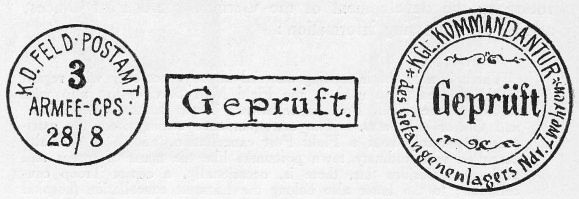 237 238 239
237 238 239
Very few postmarks of the present war have so far reached us from Germany, but Fig. 237 is a type of the Field Post Office date mark. Figs. 238, 239 are Censor marks, and the next (Fig. 240) is the cover of a letter from a prisoner of war interned at Kissingen.
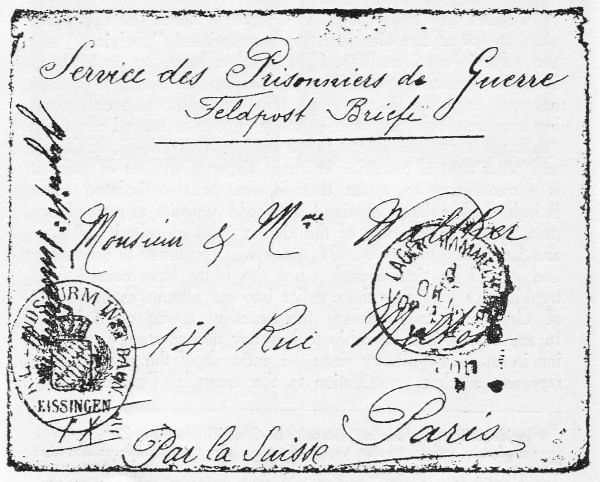 240
240
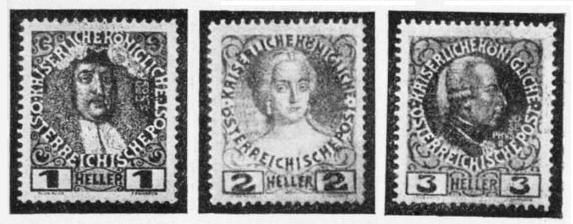 241 242 243
241 242 243
Austria. The stamps of Francis Joseph the Unlucky, who has been on the throne of Austria since the first Austrian issue appeared in 1850, do not call for more than pictorial representation here. The general postage stamps current in Austria were originally issued as a special series to mark the sixtieth year of the Emperor's reign (1908). Slightly modified, they were re-issued for the celebration of his eightieth birthday (1910). The illustrations (Figs. 241-257) show the original issue of 1908 as still current. The portraits are copied from paintings in the Royal palaces, and the subjects are: 1 heller (Charles VI.), 2 heller (Maria Theresa), 3 heller (Joseph II.), 6 heller (Leopold II.), 12 heller (Francis I.), 20 heller (Ferdinand).
Of the present Sovereign, unluckier than ever in the present war, the series comprises several good portraits. The 30 heller shows him at the time of his accession in 1848, the 35 heller a portrait painted thirty years later, 1878; the 50 heller shows him in the uniform of a Field Marshal, and on the 1 krone he figures with the insignia of the Order of the Golden Fleece.[Pg 80] Contemporary portraits appear on the 5, 10, and 25 heller (Figs. 244, 246, 249), and a particularly fine portrait stamp of large size is the 10 kronen (Fig. 257) printed in deep brown, blue and ochre.
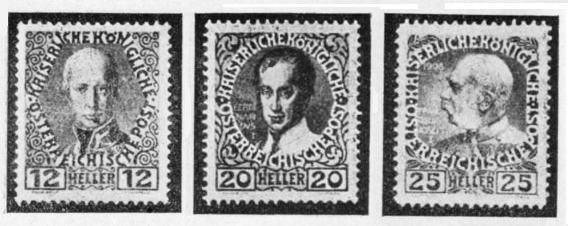 247 248 249
247 248 249
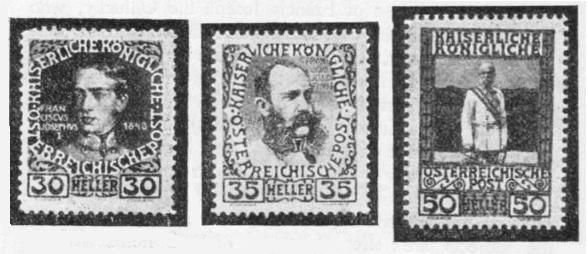 250 251 252
250 251 252
The 2 and 5 kronen stamps (Figs. 255, 256) respectively present views of the Imperial palaces Schönbrunn and Hofburg.
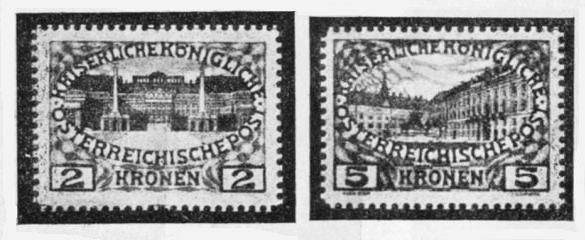 255 256
255 256
On October 4, 1914, two stamps were issued in Austria of a war charity postal character, selling for 2 heller more than the face value, the extra 2 heller going to the fund for the widows and orphans of Austrian soldiers killed in the war. The designs are adapted from the ordinary 5 and 10 heller stamps (Figs. 244, 246) by a lengthening of the stamps for the addition of the date 1914 (Fig. 258). These although paying postage to the value of 5 and 10 heller, sell at 7 and 12 heller respectively.
Bosnia-Herzegovina. The military occupation of Bosnia-Herzegovina by Austria under the treaty of Berlin, 1878, was followed thirty years later by the coup of October 5, 1908, by which the Emperor-King proclaimed his sovereignty over the two provinces. His portrait first appeared on a Bosnian stamp of the pictorial series of 1906-7 in which, incidentally, there are included views of Sarajevo where occurred the murder of the Archduke Francis Ferdinand on June 28, 1914, a tragedy which provided a pretext for hastening the German plans for a world war. In 1912 the Emperor-King's portrait re-appeared on the stamps of the military postal administration of these provinces (Fig. 259).
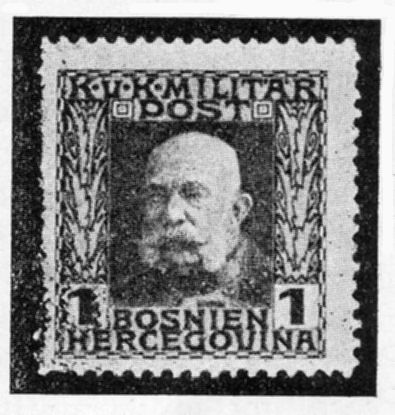 259
259
[Pg 82]The 5 and 10 heller stamps of 1906 giving views of the Pass of Narenta with a view of the river Prenj, and the valley of Vrba, are reported to have been overprinted "1914" and surcharged 7 and 12 hellers for use in collecting 2 heller contributions to the Austrian war fund.
Hungary. The stamps of Hungary, in the lower values (Fig. 260) depict the Turul, the mythical bird of the Magyars, which was said to have been the messenger between them and Heaven, and their guide along the road that took them into Hungary. When the Magyars proclaimed Arpad their first King, the Turul perched upon his forehead. Two of these low value stamps have been, with modifications and overprint, adapted for selling as war charity postage stamps (Fig. 261) at 5 + 2 filler, and 10 + 2 filler. The war inscriptions read "HADI SEGELY" (War Relief) and on label at the foot, obliterating the original inscription, "OZVEGYEKNEK ES ARVAKNAK KET (2) FILLER" (for the widows and orphans two filler). The next illustration (Fig. 262) is a charity postcard from Hungary bearing one of the war relief stamps.
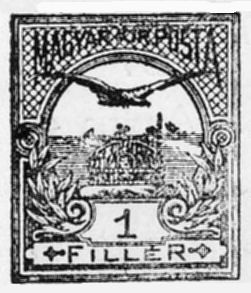 260
260
Turkey. The coming of the Young Turk has completely changed the aspect of Turkish stamps. They have robbed the collector of a rare illusion, and we owe them a grudge for it. The picturesque fancies which we treasure in our memories as the children store up the fables of the nursery, are dear to us children of a larger growth. But our love of fantastic lore suffers many a shock. Ever since the first stamps of the Sublime Empire appeared in the reign of Abdul Aziz, on whom be Peace, we collectors of stamps (on whom there can be no Peace, for in stamps there is constancy but in change) have[Pg 83] nourished a fond fancy that pictures and portraits are forbidden to the Muslim, and that Allah, who is great, and his prophet, Muhammed, have set the Curse upon such works of Satan.
Much has been written by philatelists, as well as by Muhammedan scholars, upon the subject, and the continued philatelic fidelity to the Thoughra (the Sultan's sign manual) on the Turkish stamps has ingrained into collectors the belief that the Turks would never depart from their reading of the law as set forth by Muhammed in this particular. The verse which, in the Koran, sets forth the alleged prohibition is transcribed:—
O believers! surely wine and games of chance, and statues, and the divining arrows are an abomination of Satan's work! Avoid them that ye may prosper.
The wise men of the East, who have drunk deep of the streams of wisdom that flow from the Book of Warnings, have read many different meanings into the verse, and in Turkey it has been taken to imply the forbidding of all figures, and even the ruminative game of chess is barred by the strict Muslim. We, of Christian faith, would appear to have a more emphatic[Pg 84] prohibition of the making of pictures in the translation of the Mosaic law:—
And God spake all these words, saying, Thou shalt not make unto thee any graven image, or the likeness of anything that is in heaven above, or that is in the earth beneath, or that is in the water under the earth.
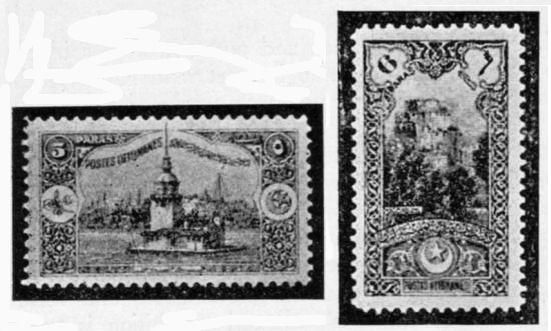 265 266
265 266
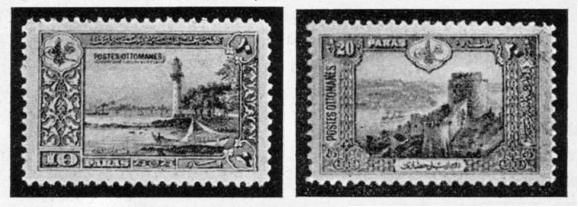 267 268
267 268
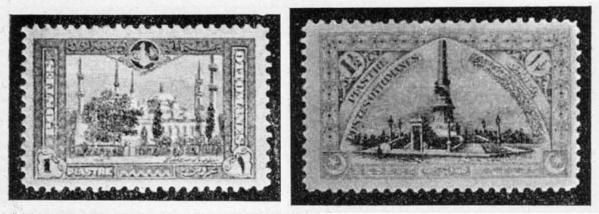 269 270
269 270
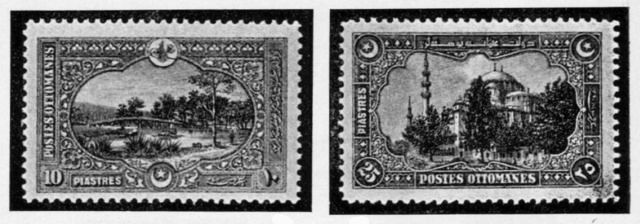 275 276
275 276
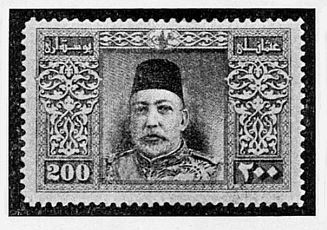 279
279
Our theologians have not regarded the second Commandment as a condemnation of the making of pictures, though many an earnest believer, during the phases of pictorial frenzy through which we have passed and are still passing, may have regarded the picture paper and the picture palace as abominations of Satan's work.
The new pictorial stamps of Turkey have dispelled one of the mellow myths of our cult, a myth which, perhaps, was simply an exaggeration of a prohibition which is more in common with Western ideas than with Western practices. For instance, there have been recorded seizures of pictorial postcards in Turkey, attributed to the Muhammedan law; but these probably concerned cards which gave offence to Muslim susceptibilities by their blatant portrayal of the unveiled faces (inter alia) of women. If the prohibition of pictures in the past has been no myth, and the late departure from precedent is the result of the advent of the New Turk, then, indeed, the New Turk hath courage, for each true believer of the Prophet must needs regard every new-born child, whether a creature of the flesh or of the mind, as a thing that is touched by Satan.
Yet one other illusion concerning Turkish stamps has been shattered of recent years. We are told now that the Crescent, so long an emblem of the Sublime Empire, owes nothing to the moon. The barking of dogs on the appearance of the moon at the siege of Byzantium may have saved the city, and the partial eclipse of the orb of night may have aided the Turks at the capture of Constantinople, but the Turkish Crescent is no memorial thereof, merely a horse-shoe or an amulet. Professor Ridgeway says it is the result of the base-to-base conjunction of two claw or tusk amulets. Says another writer, "There is no historical evidence that the Turks thought at all of the moon when they adopted a crescent as their national symbol."
Turkey's first departure from the Thoughra device for its stamps was in 1913, when a set of crude picture stamps displayed an alleged view of the new General Post Office at Constantinople (Fig. 280). Later in the same year a finely-engraved set of three denominations, 10, 20, and 40 paras, was issued to commemorate the recapture on July 22, 1913, of the fortress of Adrianople after the Balkan War. The design,[Pg 88] which was engraved in London, shows a view of the Mosque of Selim (Fig. 281).
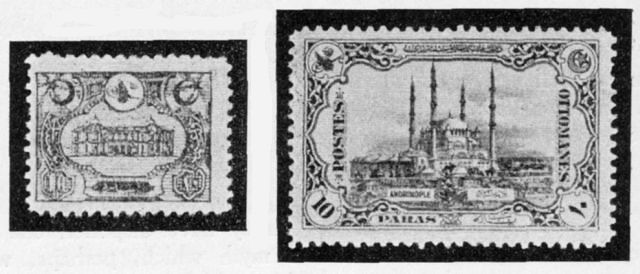 280 281
280 281
On January 15, 1914, a fine new set of London-printed stamps was issued depicting a number of scenes in the Turkish Empire and a portrait of H.M. Sultan Muhammed V. Incidentally some of the designs are of warlike interest, notably the cruiser Hamidieh on the 2 piastres (Fig. 272), Turkish War Office on the 5 piastres (Fig. 274), and the forts of the Bosphorus on the 50 piastres (Fig. 277).
The vignettes of the full set of the 1914 issue are:
| 2 | paras, | mauve. | Hippodrome Obelisk. |
| 4 | " | sepia. | Column of Constantine. |
| 5 | " | purple-brown. | The Seven Towers. |
| 6 | " | deep blue. | Leander's Tower. |
| 10 | " | green. | Fanaraki. |
| 20 | " | scarlet. | Castle of Europe. |
| 1 | piastre, | bright blue. | Sultan Ahmed Mosque. |
| 1½ | " | carmine and black. | Martyr's Monument. |
| 1¾ | " | grey and red-brown. | Bathing Fountains of Salem. |
| 2 | piastres, | green and black. | Cruiser Hamidieh. |
| 2½ | " | orange and green. | Candilli. |
| 5 | " | deep lilac. | Ministry of War. |
| 10 | " | red-brown. | Sweet Waters of Europe. |
| 25 | " | dull yellow-green. | Suleimanieh Mosque. |
| 50 | " | rose. | The Bosphorus. |
| 100 | " | indigo. | Sultan Ahmed's Fountain. |
| 200 | " | green and black. | Sultan Muhammed V. |
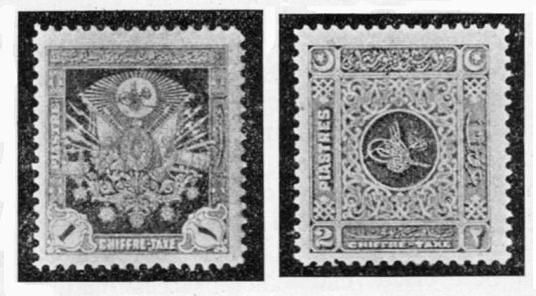 282 283
282 283
In addition there were issued four postage due stamps, one bearing the warlike "Arms" of Turkey, and the other the Thoughra, or sign-manual, of Sultan Muhammed V. (Figs. 282, 283).
Already the present war, even before Turkey had on its part opened hostilities, has produced an important effect upon the postal arrangements of Turkey by the "abolition of the Capitulations" which took effect on October 1, 1914. The various Powers interested in Turkey have for many years maintained agencies of their own postal administrations in Constantinople and other parts of the Turkish Empire, and these, owing to the untrustworthiness of the Turkish service, secured the bulk of the foreign correspondence both of Europeans and Turks. Latterly, Turkey has been endeavouring to compete more keenly with these rival post offices within its own dominions, and they have sold specially earmarked stamps to business firms for use on foreign correspondence at a substantial discount off face value.
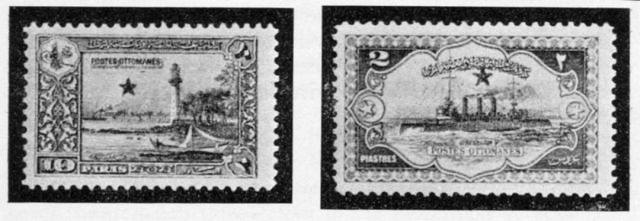 284 285
284 285
The star overprinted in blue or red (Figs. 284, 285) on the current stamps indicates those sold in this way.[Pg 90]
Each of the foreign post offices in Turkey, including our own British post office, used special stamps. Years ago, when the British office was first set up, ordinary English stamps were sold, but there were abuses of the currency values so that it was found desirable to overprint our English stamps for use in Turkey with either the value in Turkish currency, or with the word LEVANT, which effectually prevented any large purchases in Turkish money being exchanged at the English face value. The Turkish Government has long been trying to get these foreign post offices closed, but without success until the outbreak of the present war; they are all now closed, and their stamps consequently obsolete. The nations having had special stamps for their post offices in Turkey are:—
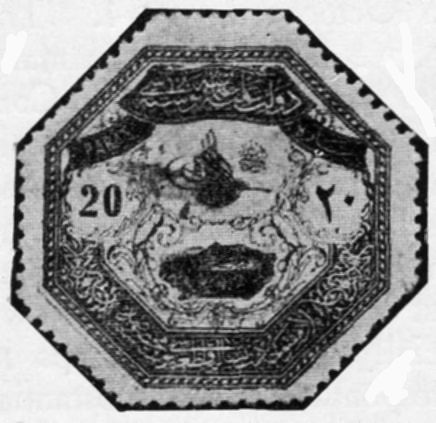 286
286
A curious set of stamps, never really required for postal duty, was issued by the Turks during the Graeco-Turkish War of 1898, under the pretext of being required for the use of the Turkish Army of Occupation. The Turkish inscription on these odd-shaped stamps (Fig. 286) reads "Special for Thessaly, that part of the country conquered." Even at the time these stamps first saw the light in Thessaly, the Turks were boarding their transports to evacuate the country. Large remainder stocks have been sold since the evacuation, and extensive forging of these stamps has been detected.
American Wars — United States — Civil War — Confederate Stamps — Hispano-American War — Vera Cruz — Canada — Mexican Revolution — South and Central America.
United States. In December, 1860, South Carolina in convention repealed the act adopting the Constitution of the United States, a move which was promptly followed by other Southern States, and led to the American Civil War. On February 18, 1861, a provisional Confederate Government under Jefferson Davis was set up at Montgomery, Alabama, with all the appendages of military and civil administration, including a post office department. The Confederate Government later moved to Richmond, Virginia, and throughout the long and bloody war from 1861-1865 the Confederate States maintained a separate postal service, with separate postage stamps. Judge John H. Reagan was Postmaster-General.
The United States postage stamps current at the beginning of the war were the beautiful series of 1851-60, and as large quantities remained in stock at Southern post offices, these issues were demonetized and replaced hurriedly by the now rare première gravures of August, 1861, which were promptly superseded by the more finished designs of September, 1861.
The Confederate States stamps lack the excellence of engraving and printing of the United States stamps, a deficiency due to the difficult conditions under which they were produced in the country or imported from England. But what they lack in this respect is more than amply compensated by their historic significance and associations. The home produced stamps were prepared under the stress of invasion; the foreign manufactured ones and much of the material for the local productions had to be brought through the blockade. In the annals of philately there are no more exciting records than those which tell of the capture of a ship bearing three De La Rue plates and 400,000 dollars worth of Confederate States stamps, which the agent of Davis's Government managed to throw overboard, or of the despatch (preparatory to the evacuation of Richmond) of printing press, dies, plates, and stamps to Columbia, in South Carolina, where they arrived only to be destroyed in the holocaust following upon General Sherman's capture of the city. The different designs of the successive issues of Confederate[Pg 92] stamps are shewn in Figs. 287-295; their history we have dealt with at length in "Confederate States of America: Government Postage Stamps."[7]
[7] Melville Stamp Books, No. 19. Stanley Gibbons, Ltd., London, 1913.
Some bogus stamps purporting to have been used in various temporary services are illustrated (Figs. 296-299), including one showing a fort at Charlestown, and another which purports to prepay "blockade postage" to Europe.
The postmasters of a number of towns in the Confederate States found it desirable pending the receipt of stamps from the Confederate Government to prepare and issue provisional stamps of their own to denote prepayment of postage. Among these are some of the rarest postage stamps known to collectors; the best authenticated issues emanated from:—
Athens and Macon in Georgia; Baton Rouge and New Orleans, in Louisiana; Beaumont, Goliad, Gonzales, Helena, Independence, and Victoria in Texas; Bridgeville, Greenville, Grove Hill, Livingston, Mobile and Uniontown in Alabama; Charleston and Spartanburg in South Carolina; Lenoir in North Carolina; Danville, Emory, Fredericksburg, Greenwood, Jetersville, Lynchburg, Marion, Petersburg, Pittsylvania, Pleasant Shade and Salem in Virginia; Kingston, Knoxville, Memphis, Nashville, Rheatown, and Tellico Plains in Tennessee; and New Smyrna in Florida.
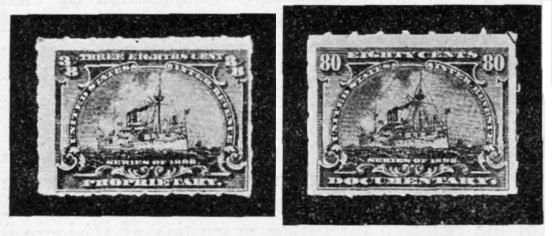 300 301
300 301
The war with Spain produced a considerable effect upon stamp issues; but the war tax stamps which were very popular with young collectors by reason of their bearing a picture of the battleship Maine (Figs. 300, 301) were in no sense postage stamps, though often affixed to letters as small contributions to the war funds. Throughout the campaign there were many United States military postal cancellations used in Cuba (Fig. 302), Porto Rico (Fig. 303), and the Philippines (Fig. 304), and United States postage stamps were later overprinted for these and other former Spanish colonies, e.g., Cuba, Guam, Philippine Islands and Porto Rico (Figs. 305-307). These have since been replaced by definite issues for the Republic of Cuba, and for the Philippines.
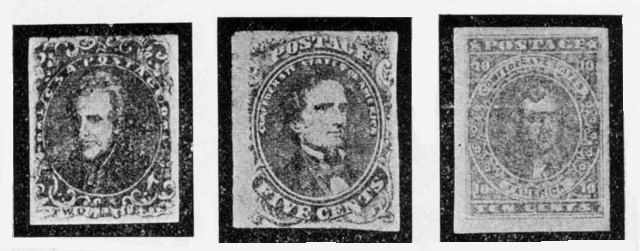 287 288 289
287 288 289
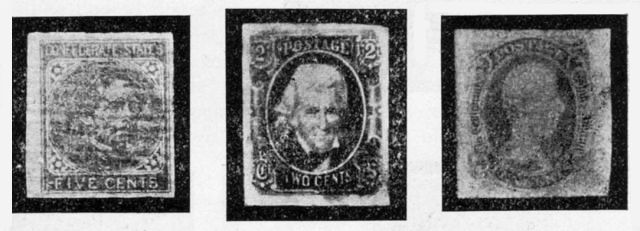 290 292 293
290 292 293
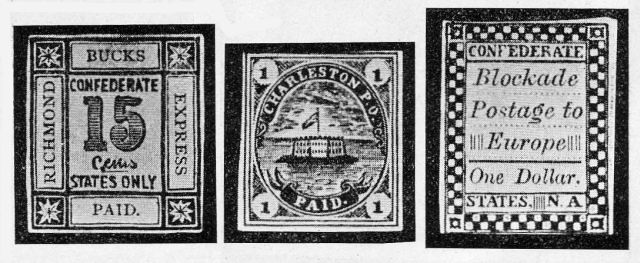 297 298 299
297 298 299
[Pg 95] The United States stamps offer a very wide field for association with war interest, many of them bear portraits of warrior heroes, and their cancellations in connection with expeditionary forces cover a wide range of territory from the neighbouring and troublesome republic of Mexico (where the United States recently used its own stamps at the post office of Vera Cruz) to China.
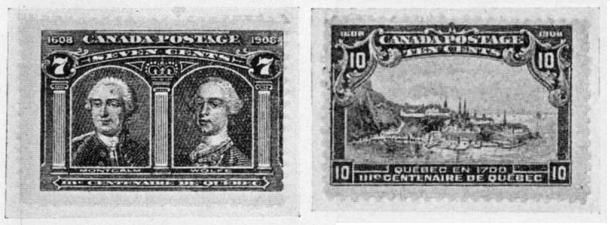 310 311
310 311
Canada. Our great North American dominion gave us a patriotic Empire stamp a few years ago to mark the introduction at Christmas 1898, of Imperial Penny Postage (Fig. 308). It shows a map of the world on Mercator's projection with the British possessions coloured in red, and with a line quoted from[Pg 96] Sir Lewis Morris's jubilee ode, "We hold a vaster Empire than has been." The "bumptiousness" of the quotation led Punch to suggest a few alternatives:
The difficulties of printing a map of the world in colours within the space of a postage stamp led to "minor" geographical inexactitudes, such as the annexation by the red colour, of the United States, the invasion of France by England, and the removal of the Cape of Good Hope out into the sea. But unlike the Dominican Republic's map stamp of 1900 it did not lead to complications with other countries.
Canada's Quebec Tercentenary issue includes some stamps of martial interest (Figs. 309-311), the 5 cents shows the French Governor Champlain's house in Quebec, round which a wide ditch was dug and breastworks were thrown up and cannon mounted to protect the colonists from the savages. Generals Wolfe and Montcalm are portrayed on the 7 cents, the 10 cents shows the old city and fort of Quebec in 1700, and the other denominations show incidents in the exploration of Canada and portraits of King Edward and Queen Alexandra, and of King George and Queen Mary.
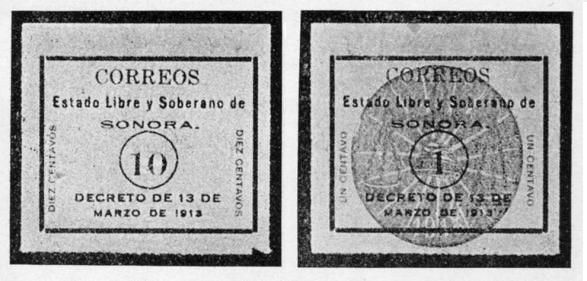 312 313
312 313
Mexico. Mexican stamps from 1856 to the rise of Porforio Diaz demonstrate some of the political changes through which the country has passed, from Republic to Empire, and back to[Pg 97] Republic. Revolution has brought about provisional stamps of a rare order, such as the Guadalajara, Chiapas, and Campeche stamps of 1867-1868, and the more recent issues of the "Constitutionalist" party for Sonora (Figs. 312-314) and Tamaulipas (Fig. 315).
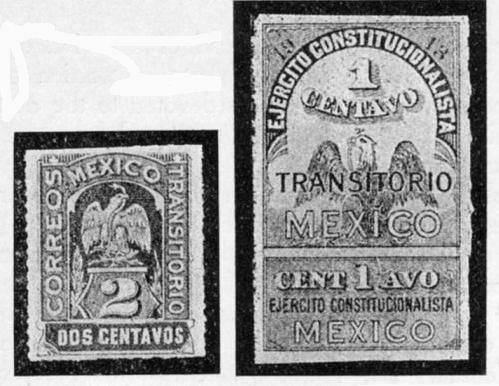 314 315
314 315
Figs. 316, 317 represent ordinary Mexican stamps commandeered and overprinted by the rebels.
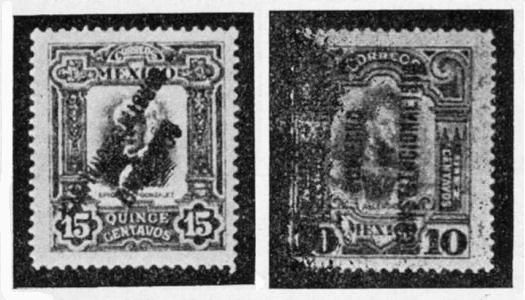 316 317
316 317
Martial portraits figure on the stamps of many of the South and Central States; to mention them all would require a goodly sized dictionary of American biography. In addition, specialists find much interest in tracing, by extra-territorial postmarks, the movements of troops in the various wars between Brazil and Paraguay, Chili and Peru, etc.; and many of the countries give us scenes recording outstanding incidents in their histories, especially on their issues commemorative of the centenary of their freedom from the Spanish yoke. Chili, for example, depicts the battles of Chacabuco, Roble, Maipo, the sea fight of April[Pg 98] 27, 1818, between the Lautaro and the Esmeralda, and another ending in the capture of the Maria Isabella on October 28. In this series also is a portrait of the renowned Admiral Cochrane, the 10th Earl of Dundonald, who organised the Chilian Navy and played a great part in Chili's struggles for freedom from Spain.
Ecuador's issue of 1896 marks the end of a period of civil strife and the triumph of the Liberal Party, a portion of the proceeds of the sale of the stamps being devoted to the destitute families of soldiers killed while serving in defence of the Liberal cause.
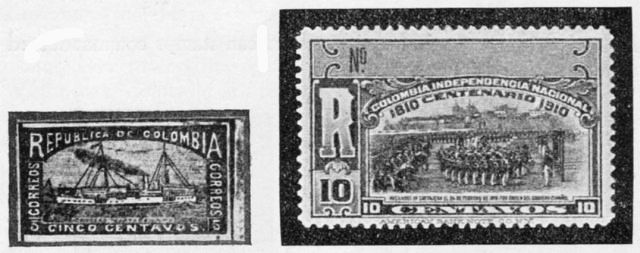 318 319
318 319
Colombia gives us a number of stamp designs of war-like interest, including warrior heroes, and a crude picture (Fig. 318) of the cruiser Cartagena. A particularly bitter commemoration of the centenary of the independence of Colombia in 1910 was the picturing on a registration fee stamp of the wholesale executions ordered by the Spanish victors at Carthagena on February 24, 1816. (Fig. 319). To this stamp objections were raised by the Spanish Minister at Bogota, and in deference to his protests it was withdrawn from circulation.
Guatemala displays its Artillery Barracks (Fig. 320). The much disturbed Dominican Republic warns off possible invaders by displaying the fortress of Santo Domingo. Its map issue of 1900 (Fig. 320A), owing to a dispute over the boundary indicated nearly led to war with the Haytian Republic. Hayti shows the fortress of Sans Souci (Fig. 321). Peru having had its stamps much overprinted by the Chilians in 1881-1883, vaunts more peaceful subjects on its recent picture stamps, e.g., its General Post Office, Municipal Institute of Hygiene, and the Lima Medical School. Uruguay, after its civil war of 1904, added a "peace" overprint to its contemporary stamps, reading PAZ-1904. It also illustrates the fortress and port of Montevideo,[Pg 99] and its cruiser of the same name on its issues of 1908 and 1909 (Fig. 322), and Venezuela has given us crude sketches of the revolutionary steamer Bankigh (Fig. 323), and a map stamp illustrative of the great boundary dispute with Great Britain.
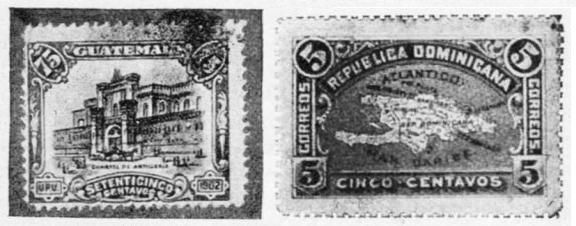 320 320A
320 320A
Brazil also furnishes examples of stamps specially furnished to soldiers and sailors for use on their letters home in war-time. These were printed by a stationer in Rio de Janeiro and were used during the war with Paraguay 1865-1870. The army franks are inscribed EXERCITO (Army), and those for the sister service ARMADA (Navy).
Miscellaneous Wars and Commemorations.—Patriotic Empire Stamps — Victoria — New Zealand — Barbados' Nelson Stamp — A Dutch Naval Commemoration — Balkan Wars — Greece — Albania — Epirus — Bulgaria — Roumania — Italy — Portugal — Spain — Mysterious Melillas — China.
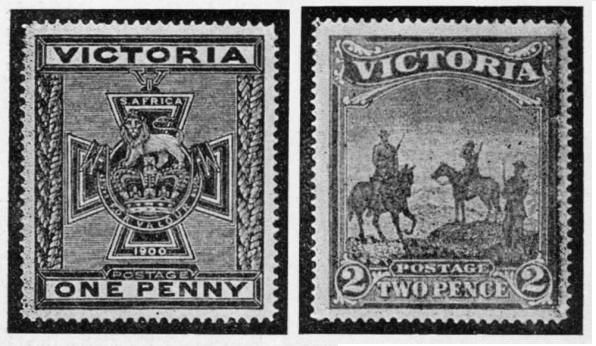 324 325
324 325
Australasia has not had much occasion for war stamps, but it is worthy of note that at the time of the South African War Victoria issued two postage stamps of patriotic designs, obtained in public competition. The Victoria Cross design (Fig. 324) gained the prize for the penny stamps and the prize for the twopence stamps was awarded for the other design (Fig. 325) showing a picket on foot and armed scouts scanning the horizon of the open veldt in the Transvaal, whilst in the distance are the faint outlines of the hills which the British have had to scale. The central figures in the latter design are in the uniform of the Victorian contingent. These stamps sold at 1s. and 2s. each although they only prepaid 1d. and 2d. postage respectively, the balance going to the Patriotic Fund.[Pg 101]
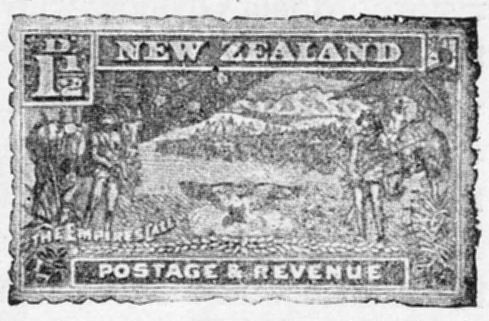 326
326
In connection with the same campaign New Zealand issued in 1901 a stamp printed in a khaki colour to commemorate the sending of a New Zealand contingent to the war. The stamp (Fig. 326), designed by Mr. J. Nairn of Wellington and engraved in New York, pictures the part of the contingent sent as New Zealand's response to "the Empire's call."
Barbados marked the centenary of the battle of Trafalgar by an issue of stamps depicting the "first monument erected to Nelson's memory, 1813" (Fig. 327). The monument is in the capital of the Colony, Bridgetown, but its claim to be the first erected to Nelson's memory is contested.
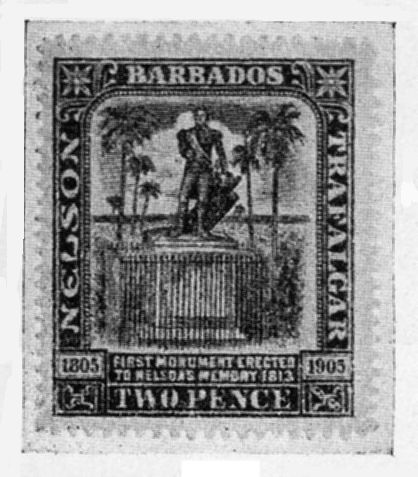 327
327
Another naval hero, Michael A. de Ruyter, Admiral-in-Chief of the Dutch Fleet, is commemorated on a set of stamps of Holland issued in 1907 for the ter-centenary of his birth. This design, in addition to a portrait of the Admiral, depicts a battle at sea (Fig. 328).
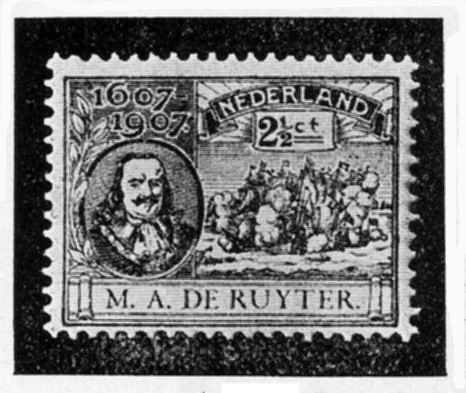 328
328
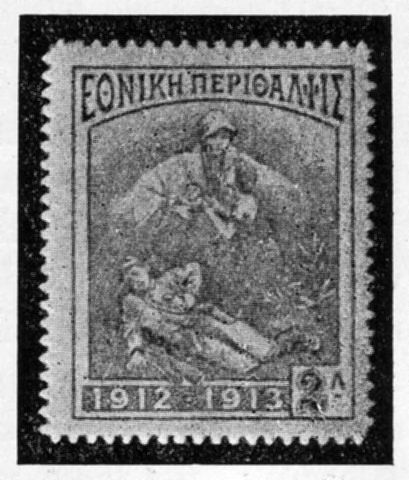 329
329
The recent Balkan Wars (1912-13) would require a volume to describe in detail the philatelic results. Two Greek stamp designs commemorate the victories of the troops allied against Turkey. One shows the cross of Constantine over the Acropolis and city of Athens and the Bay of Salamis; the other depicts the eagle of Zeus flying[Pg 102] over Mount Olympus with a snake in its talons. Fig. 329 shows the design of two war charity stamps sold for the benefit of Greek soldiers incapacitated in the campaign, and for the widows and orphans of the killed. Greece overprinted stamps very lavishly for territories occupied during the war. When the fleet occupied Mytilene the Greek authorities overprinted the Turkish stamps they found there with a Greek inscription rendered "Greek occupation—Mytilene." Lemnos was furnished with Greek stamps overprinted LEMNOS in Greek characters, and many other places were provided with Greek stamps overprinted with an inscription signifying "Greek Administration." In Samos four issues of new stamps appeared in 1912-1913, and Icaria's Independent Government stamps prepared just prior to the Greek occupation were overprinted "Greek Administration."
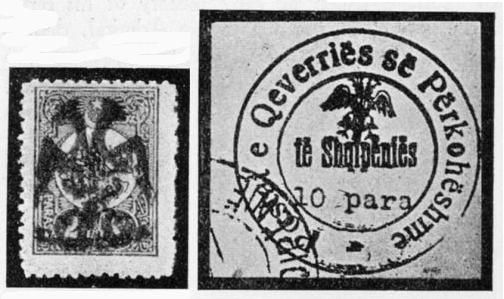 330 331
330 331
Albania's separate stamp issues were an outcome of the Balkan Wars. The first were created in 1913 by overprinting Turkish stamps with a device of a double-headed eagle and the word SHQIPENIE (Fig. 330). Since then four or five new issues have appeared, crude labels of circular handstamp pattern (Fig. 331) with the value typewritten. More recently a series has appeared depicting Skanderbeg, the warrior hero of the Albanians, and these were overprinted in March, 1914, with an inscription "7 Mars. 1467. rroftë mbreti. 1914" to commemorate[Pg 103] the arrival of Prince William of Wied as Mpret. The year 1467 was the date of the death of Skanderbeg.
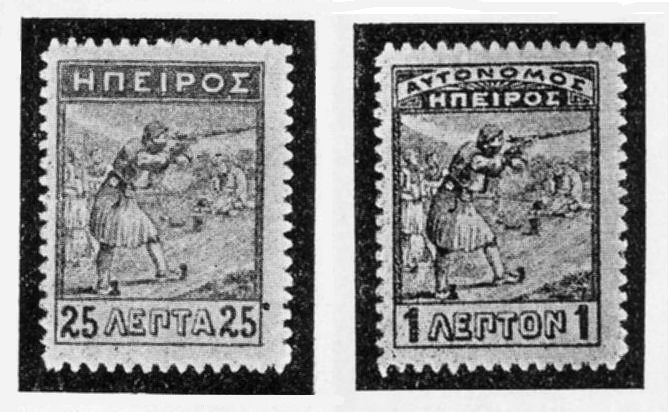 333 334
333 334
The "autonomous state of Epirus," another outcome of the Balkan troubles, has given us some quaint stamps. The first was the skull and cross-bones issue (Fig. 332), the inscriptions on which read "Liberty or death—Defence of the fatherland—Lepta 10." This was succeeded by a more ambitiously designed stamp (Fig. 333) showing an evzone or light infantryman in the act of firing. The simple name "Epirus" was extended to "Autonomous Epirus" (Fig. 334). Other crude issues have appeared in Epirote districts, as yet not very satisfactorily authenticated. These include Koritza (Fig. 335) and Moschopolis (Fig. 336), both places in lower Albania.
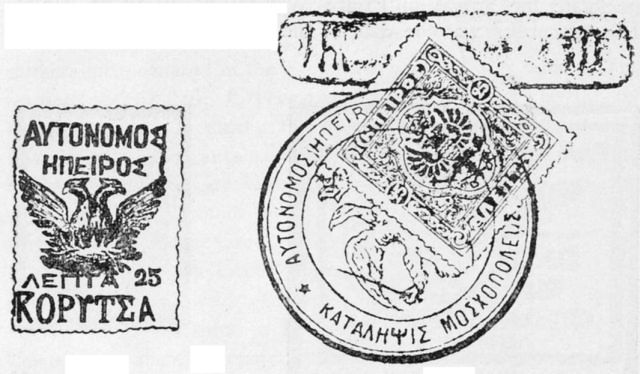 335 336
335 336
Another curious provisional is one for Gumuldjina (Fig. 337) in the vilayet of Adrianople.[Pg 104]
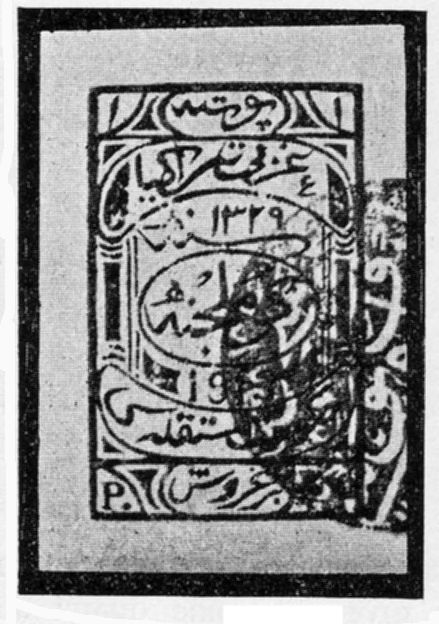 337
337
Crete's troubles may be ended with the final settlement of the Turks; in its stamps since 1898 we see the influence of the British, Russian and Greeks, and a remarkable range of revolutionary stamps. On one modern stamp of 1907 (Fig. 338) is depicted the landing of Prince George of Greece at Suda on his appointment as High Commissioner. He is being received by Admirals of various Powers, Noel of Great Britain, Skrydloff of Russia, Pottier of France, and Bettolo of Italy. A still more recent stamp of Crete shows the fort at Suda, and was issued to celebrate the raising of the Greek flag on May 1, 1913.[Pg 105]
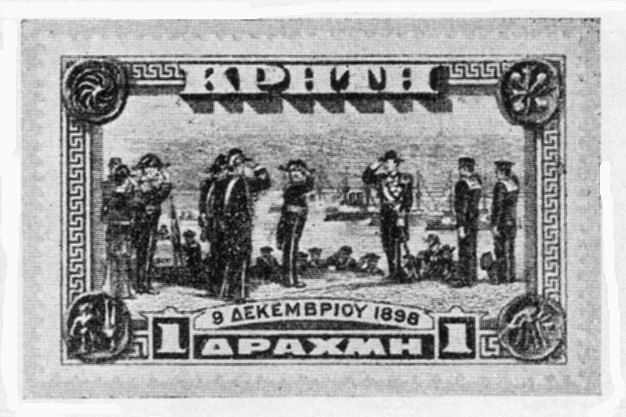 338
338
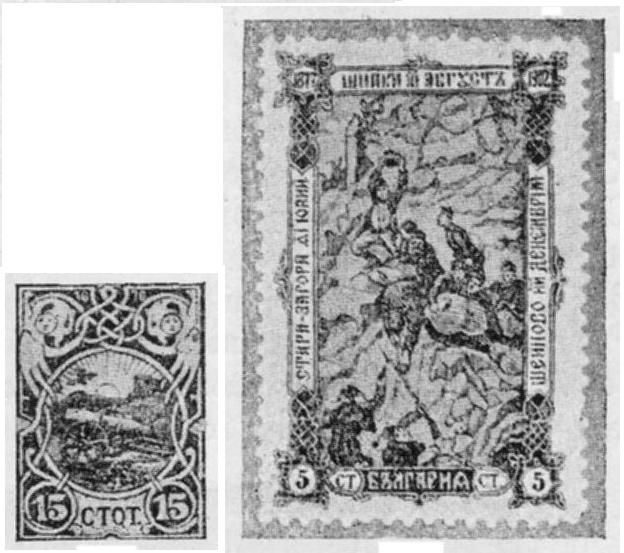 339 340
339 340
On two stamps of 1901 commemorative of the War of Independence Bulgaria pictured a cherry wood cannon, a home-made affair used by the Bulgarian patriots against the Turks, and drawn from one which is preserved in the national museum at Sofia (Fig. 339). The following year, 1902, the 25th anniversary of the battle of Shipka Pass (August 21, 1877) was the occasion for a set of stamps showing a view of the ravine with the Bulgars tumbling rocks down upon their enemies (Fig. 340). Later stamps of this country show some interesting portraits of King Ferdinand (Figs. 341-343) in naval and military uniforms, and one showing the King with the sceptre in his right hand and the orb in his left, and wearing the garb of the ancient Tsars of Bulgaria. These form part of a fine pictorial issue of 1911, and it is noteworthy that these stamps may be found with Turkish cancellations, used by the victorious Bulgars in the recent campaign before they could substitute[Pg 106] Bulgarian postmarks for those left behind by the Turks. In 1913 the pictorial set up to the 25 stotinki, was issued with an overprint in Sclavonic characters signifying "War of Liberty" to mark the successes against the Turks.
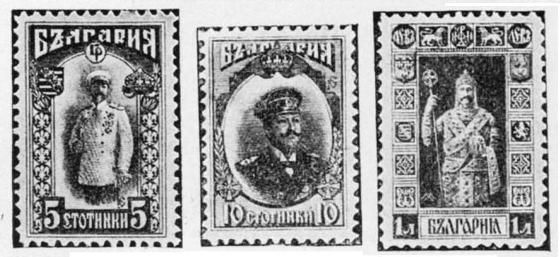 341 342 343
341 342 343
The enlightened Prince Cuza was responsible for the introduction of many reforms in Roumania, among them being postal reform, with the use of adhesive stamps, those of 1865 bearing his portrait. He was obliged to abdicate the year following the issue of the stamps as a result of a conspiracy. The late King Charles was his successor, there being no further developments to recall. Rather in this case we read from our stamps the more peaceful story of the growth of the King's beard. In commemorating the 40th year of King Charles' reign a long pictorial series of stamps showed among other pictures Prince Charles saluting the first shot fired at the Battle of Calafat, the meeting of Prince Charles and Osman Pasha in 1878, the Roumanian Army crossing the Danube in 1877, the triumphant entry of the victorious army into Bucharest, and Prince Charles riding at the head of his Army in 1877.
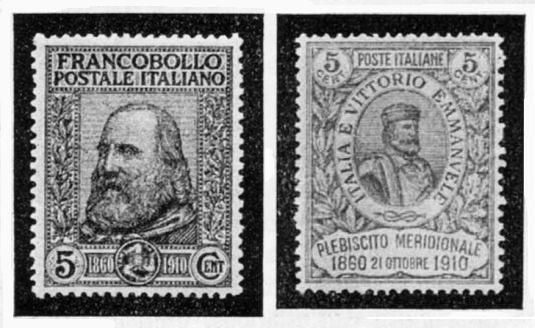 344 345
344 345
Italy has given us commemoration portraits of Garibaldi (Figs. 344, 345), and its war with Turkey in 1911 extended the use of the overprinted Italian stamps of Tripoli (Figs. 346-348). From the Italian pages of our albums much of the story of the makings of United Italy may be learnt chiefly by the absorption into one of all the separate stamp issuing states, Sardinia, Naples, Sicily, Parma, Modena, Romagna, Tuscany, and, although much later, the States of the Church. The jubilee of the Union was commemorated by a set of four fine designs in 1911, one by Signor A. Sezanne showing (Fig. 349) a sword grasped by a hand, symbolical of the Italian Union, and at the sides are branches of palm in memory of the warriors who died in the Wars of Independence.
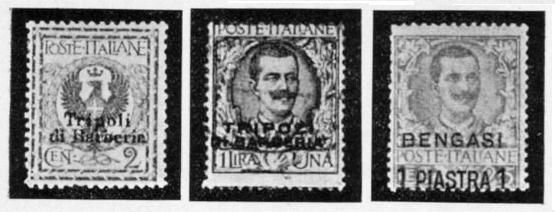 346 347 348
346 347 348
Portugal does not offer much war-interest, though plenty of historical associations, in its postage stamps. The Republic followed so soon after the assassination of King Carlos that the stamps with the portrait of the young King Manuel had no long service without a distinguishing mark to show that the stamps were issued by the Republican Government (Fig. 350). These have since given place to a distinctive Republican design (Fig. 351). It is interesting to note that the Red Cross Society and the Civilian Rifle Corps in Portugal have a limited privilege of free postage, for which they use their own special stamps (Figs. 352, 353).
The postage stamps of Spain introduce us to the revolutionary element in 1868 in which year Isabella II. fled to France as a result of the revolution under Prim and Serrano. That was in September, and the current stamps were overprinted before the end of the year with the words HABILITADO POR LA NACION (authorised by the nation), signifying that they were now being used under the Provisional Revolutionary Assembly. One of the forms of overprint reads HALILITADO POR LA JUNTA REVOLUCIONARIA. Some of the known overprints did not emanate from the headquarters of the Provisional Government but were added at the order of local juntas or revolutionary councils. The familiar emblematic figure of Spain followed on the stamps issued on January 1, 1870.
The republican form of government did not last long, and in 1870 the Duke of Aosta, second son of King Victor Emmanuel of Italy, was chosen King of Spain, now a limited monarchy, as Amadeus I., and his portrait was introduced on the stamps[Pg 109] of 1872-73. The tiny ¼c. de peseta stamps of the former year bear a small design of a royal crown.
Changes at this period followed in rapid succession, and Amadeus failing to make headway as a constitutional Sovereign resigned his troublesome crown in February, 1873, in favour of peaceful retirement in Italy. The little stamps aforementioned were changed under the new government—this time another form of republic—to shew a mural crown in lieu of the royal one, and the portrait of Amadeus gave way to an emblematic figure Peace in July, 1873. Peace! What most desire, but few can obtain and keep. Nor was the next stamp design of Justice (July, 1874) much less wide of the mark.
There were actually in Spain between the revolution of 1868 and the restoration of the house of Bourbon three different types of republic, the limited monarchy under Amadeus, and a military dictatorship. In 1872, too, the pretender Carlos proclaimed himself King of Spain, and issued the celebrated Carlist stamps from 1873 to 1875. So far as the general issues of Spanish stamps are concerned, their changes subsequent to the restoration of Alphonso XII., son of Isabella II., are free from further revolutionary changes, but there are postal war tax stamps of 1874-1879, and 1898 (Fig. 354).
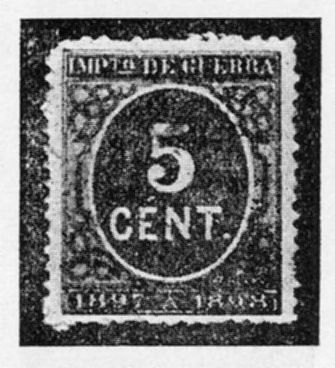 354
354
A remarkable instance of planting a bogus set of stamps on collectors occurred in connection with the Melilla campaign in 1893-1894. In the set there are 53 or possibly 54 varieties, each for a different detachment of the Spanish forces. The inventor of the scheme apparently launched his venture by going about amongst the troops, sailors, officers, etc., distributing specimens of the stamps he had conceived in their behoof, and consequently the appearance of some of the labels on letters emanating from soldiers and others at the war gave colour to the supposition that these gaudy labels had been provided by a generous and otherwise unoccupied government at Madrid.
Of the fifty-three stamps, all except Nos. 1 and 2 are perforated. Nos. 1 to 5 are in design of Figs. 355, 356, and were supposed to have been for the use of the five Army Corps.[Pg 110] The colours are (1) black frame, arms red and yellow; (2) blue frame, arms red and yellow; (3) as No. 1 perforated; (4) as No. 2 perforated; (5) black, red, and orange;
7-13. One for each Regiment of "Cazadores" or Chasseurs, the name of the Regiment on each stamp.
14-35. One for each Regiment of Foot, with the name of a Regiment on each stamp.
36-42. One for each warship, the name of a ship on each stamp.
43. Commissariat Department.
44. Civil Guard; a disciplinary Corps, half military, half police, à la Royal Irish Constabulary.
46. Engineers.
47. Artillery.
48. Medical Staff Corps.
49-53. One for each Fort; name of the Fort on each stamp.
China's troubles during the Boxer rebellion were reflected in the stamp album by the "C.E.F." stamps of India (see Chapter II.) and by the use of the stamps of several of the Powers co-operating in the defence of the Legations. The revolution of 1912 made its mark in the overprinting of the Imperial stamps with various republican overprints (Figs. 366, 367) and the revolution when completed was commemorated by two sets of stamps issued in November 1912; one set bears the portrait of Dr. Sun Yat Sen in a frame in which are unripe ears of wheat, and inscribed "in commemoration of the revolution" (Fig. 368); the second set bears the portrait of President Yuan Shi Kai, and in this set the ears of wheat are ripe, and the inscription reads "in commemoration of the republic" (Fig. 369).
Although not issued in connection with warfare, it may be noted that the only separate postage stamps of Heligoland appeared while the island was in British possession (Fig. 369A). Since its cession to Germany in 1890 the islanders have used German stamps.
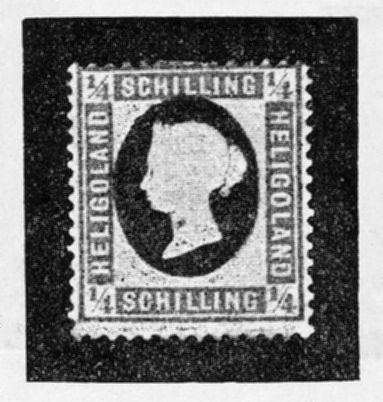 369A.
369A.
The Great War of 1914-1915. Check-List of New Stamps.
At New Year, 1915 it is too early to show more than a few of the first philatelic signs of the great world war which is being waged between
But the developments are already full of significance, and the stamps of each of the countries at war acquire a new interest in the occasions for their extra-territorial use as the armies invade the territories of their opponents. At the beginning of August the Germans invaded France and Belgium, accompanied, or followed shortly, by field postal organisations, of which few particulars are yet available. By the middle of August the French had entered Alsace and German Lorraine, and the Russians having invaded East Prussia set up posts there in which they used the current Russian stamps. The British Expeditionary Force, with its well-equipped Army Postal Service, was in France by the 16th. About this period the Germans invaded Cape Colony. The Tsar's promise of autonomy to Poland may ultimately demonstrate its fulfilment in the issue of new stamps for Poland. France issued its first Red Cross stamp, and similar war charity stamps have since appeared in Monaco, French Morocco, Russia, Austria, Hungary, and Bosnia. Japan's declaration of war, and successful attack on Kiaochow, probably led to the use of Japanese soldiers' stamps (Figs. 201, 202) by the forces engaged, possibly along with Indian stamps overprinted C.E.F. (China Expeditionary Force, Fig. 61), for the use of the co-operating British land forces. On the 26th the British along with the French took Togoland, and have already issued stamps of the Anglo-French occupation of that former German colony (Figs. 384-386). Prior to their issue the British Gold Coast stamps were used in Togo for a time (Fig. 370). Towards the end of the month the bombardment of[Pg 114] Malines destroyed the Belgian State Stamp-printing works, rendering it necessary to create an entirely new series of Belgian stamps when the Government finds itself in a position to do so. On the 29th Samoa was taken by the New Zealand forces, and English stamps have been used there (Fig. 371), and already a provisional and a definitive set of British Samoa stamps have appeared (Figs. 382, 383).
[Pg 115]German attacks in September on various British and French colonial possessions may in some cases leave philatelic records, chiefly in the way of war postmarks which may be looked for from the affairs in Nyasaland, British East Africa, Zanzibar, German South-West Africa, etc. Postmarks, too, record the withdrawal of the French Government to Bordeaux (Figs. 155, 156), and the sending of great loyal contingents from Canada (Fig. 372) Australia, and New Zealand (Fig. 373). The effect on stamp issues caused by Turkey's abolition of the capitulations has already been referred to as rendering a considerable number of stamp issues obsolete, and this event has been commemorated on the Turkish issue, which, by the way, was printed in London. Australia's capture of German New Guinea and the Bismarck Archipelago, is already reported to have been followed by the re-issue of the German colonial stamps of New Guinea (Figs. 370A, 370B) with a British "G.R.I." overprint.
Some postal aspects of the retirement of the Belgian Government to Havre in October (Fig. 216) and the issue of German stamps for Belgium (Fig. 209) have already been referred to.[Pg 116] Turkey's entry into the war in November may have the effect of removing Turkey from the list of European stamp-issuing States, and has already led to the long anticipated proclamation of a British protectorate over Egypt, and the annexation of Cyprus. The fall of Tsingtau renders obsolete the German colonial type of stamp for Kiaochow, although there may have been some interesting provisional issue here, and also possibly in the Marshall and Marianne Islands.
All these and many more happenings of the past few months will leave their traces in new stamps, or in new uses for stamps, and when at last the enemy shall be vanquished and Peace reigns once more, one of the most fascinating histories of the great War will be that recorded in the pages of the stamp album.
The following is a synopsis, or check list, of distinctive postage stamps already issued in connection with the war. Issues reported but not yet seen by or satisfactorily vouched for to the present writer are not included.
October 4, 1914. War Relief stamps. Current design adapted (Fig. 258) sold at 2 heller over face-value.
October 2, 1914. Red Cross Stamps. Lithographed on white wove unwatermarked paper. Perf. 13½. White gum.
(a) Head of King Albert (Figs. 210, 211).
(b) Monument design (Figs. 212, 213).
October, 1914. Current German Empire stamps, overprinted in black "Belgien," and new value in Gothic type (Fig. 209). Perforated 14. Issued in Brussels.
October (?), 1914. War Relief stamps. 5 and 10 heller stamps of the 1906 issue overprinted 7 and 12 heller, respectively.
August 18, 1914. Contemporary 10 centimes stamp, surcharged "+5c." in red (Fig. 150).
September 10, 1914. Definitive stamp. Sower design adapted, inscription reading "CROIX-ROUGE POSTES" (Fig. 151).
September 1, 1914. Red Cross stamp. The 10 centimes "Rights of Man" type, already overprinted "10," and native inscription, further surcharged "+5c." (Fig. 153).
October, 1914. War Relief stamps. The 5 and 10 filler "inundation" stamps of 1913 overprinted in black in the centre of the stamp "Hadi Ségély" (War Relief) and on label at the foot, obliterating the original inscription, "Ozvegyeknek es arvaknak ket filler" (for the widows and orphans two filler) (Fig. 261).
Seventeen values 1, 2, 3, 5, 6, 10, 12, 16, 20, 25, 30, 35, 50 and 60 filler, and 1, 2, and 5 korona.
October, 1914. Stamps of India overprinted I.E.F. in seriffed type, for use with British troops on the Continent (Figs. 76-85). Perf. 14.
October, 1914. Red Cross stamp. Current 10 centimes stamp of this Principality, surcharged "+ 5c." in red (Fig. 152).
October, 1914. Provisional Issue. German Colonial (Ship) type for DEUTSCH-NEU-GUINEA, overprinted "G.R.I." and new value in English. (Similar to Figs. 374-381.) Perforated 14.
November 26, 1914. War Charity stamps. Surface-printed at the Russian Imperial State Printing Works on enamelled surface coloured papers (Figs. 189-192, see frontispiece). Sold for 1 kopec extra per stamp.
September 3, 1914. Provisional Issue. German Colonial (Ship) type for Samoa overprinted "G.R.I." and new value in English (Figs. 374-381). Wove paper, unwatermarked. Perforated 14.
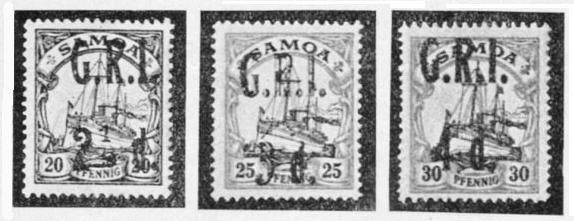 377 378 379
377 378 379
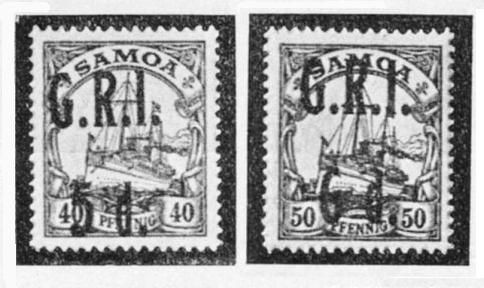 380 381
380 381
September 29, 1914. Permanent Issue. New Zealand stamps overprinted "Samoa" in sans-serif type 2mm. high and 14mm. long. The type of stamp is indicated in brackets (Figs. 382, 383). Orange-red overprints for ½d., 2d., 2½d.; and blue for 1d., 6d., and 1s. White wove paper. Watermarked "N.Z." single-lined and Star. Perfs. various.
October, 1914. German Colonial stamps for Togo overprinted "Togo—Anglo-French—Occupation" in three lines in black (Figs. 384-386). Wove paper, perforated 14.
(a) Surcharged with new value in pence (Figs. 384, 385).
(b) Without new value (Fig. 386).
October, 1914. Similar stamps, but with overprint reading "TOGO—OCCUPATION—FRANCO-ANGLAISE," and new value in French currency.
October, 1914. Current stamps (see Figs. 263 et seq.) overprinted (?) in commemoration of the closing of all foreign post offices in Turkey, as a consequence of the abolition of the Capitulations. The overprint is in two lines of Turkish characters.
[This check list of stamps of the war will be revised, continued and presented as a supplement which will be given away from time to time with The Postage Stamp (1d. weekly), of all newsagents, or by post 4s. 4d. per annum from the publishers, S. R. Le Mare, 21 Paternoster Square, London, E.C.][Pg 122]
Egypt.—An event of the greatest interest to philatelists is the termination of the suzerainty of Turkey over Egypt, and the placing of the latter country under British protection. As a British protectorate, Egypt will be transferred to the British Empire division of the stamp catalogues, and a greatly increased interest will be taken in the postage stamps of the land of the Pharaohs, with the result that the earlier issues will rise appreciably in value. As recently as January 8, 1914, a handsome new series of stamps was issued in Egypt, on the anniversary day of the accession of the now deposed Khedive, Abbas II. These were not of a commemorative character, but were issued on the anniversary as a compliment to the then reigning Khedive. They probably call for no change in the designs under the new conditions, and as they are denominated in English the present stamps may be continued in use. But they will probably be changed in regard to the watermarked paper on which they are printed, as the watermarked device is that popularly known as the "star and crescent" (Fig. 387), although modern authorities appear to agree that the Turkish symbol is not a crescent (vide p. 87). The new Egyptian flag, under Sultan Hussein I., is red with three silver crescents each enclosing a star, instead of the Turkish flag with the single "crescent" and star. Thus although a new form of watermark may not be deemed necessary, a change to the "multiple" (or as printers term it, the "all-over") watermark of similar device would appropriately denote the new regime.
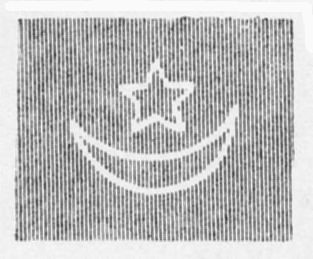 387
387
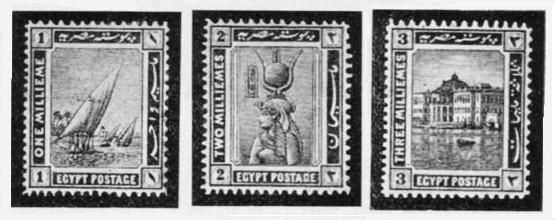 388 389 390
388 389 390
The designs on the fine series of stamps (Figs. 388-397) now current in Egypt are:—1 millieme, sepia: gyassas or sailing-boats on the Nile; 2m., green: Cleopatra in the garb and head-dress of the goddess Isis; 3m., orange-yellow: the Ras-el-Tin Palace in the Muhammedan quarter of modern Alexandria; 4m., vermilion: the Pyramids of Giza; 5m., lake: the Sphinx of Giza; 10m., cobalt: the two Colossi of Amenophis III. on the banks of the Nile at Thebes; 20m., olive: the Pylon or Gateway to the Karnak Temple; 50m., lilac: the Citadel at Cairo; 100m.,[Pg 123] slate: the Rock Temple at Abû Simbel, Ipsambul; 200m., marone: the Aswân Dam, at the first cataract of the Nile.
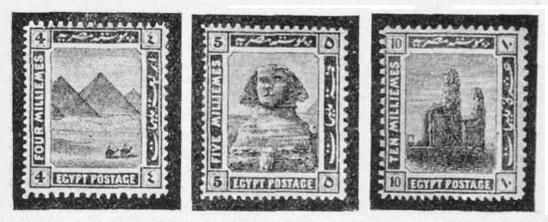 391 392 393
391 392 393
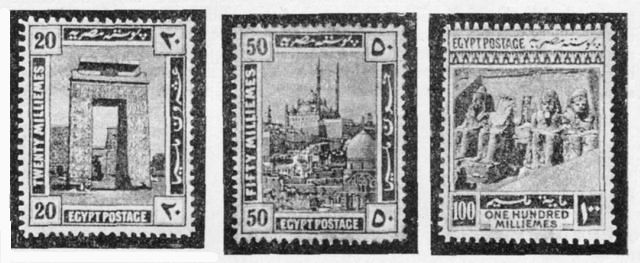 394 395 396
394 395 396
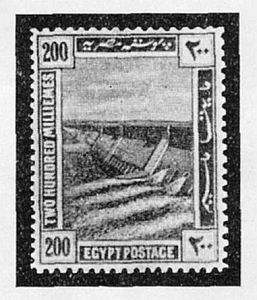 397
397
In view of the great future now opening up for British philatelists in the study and collection of Egyptian stamps, the present writer has completed a full illustrated history of these stamps for publication in the "Melville Stamp Books series," published by Messrs. Stanley Gibbons, Ltd., 391 Strand (see page 2). This will be issued almost simultaneously with the present volume.[Pg 124]
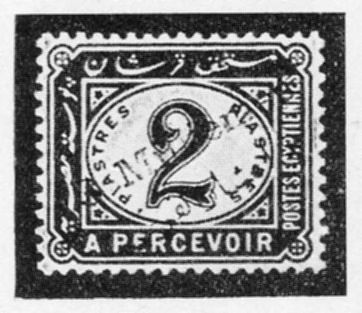 398
398
An Egyptian stamp which might have been included in the body of the present work is Fig. 398, a postage-due stamp issued in 1898. At that time the Egyptian postal regulations charged 3 milliemes for prepaid letters but double that sum (6 milliemes) for unpaid letters, from or to non-commissioned officers and men of the Egyptian Army in garrison on the frontier, as well as at Suakim and Tokar; the same tariff was applicable to soldiers taking part in the Expedition to the Sudan. In consideration of the fact that such soldiers would be most frequently in places where they would be unable to get postage stamps, the authorities decided that unpaid letters sent by them should only be liable to the single rate of 3 milliemes instead of the double rate of 6 milliemes. But as there was no postage-due stamp of 3 milliemes to use in collecting this sum, it was temporarily permitted to use a 2 millieme stamp, with half of another 2 millieme stamp divided diagonally, until the surcharged stamp (Fig. 398) 3 milliemes on 2 milliemes could be prepared and issued.
Sudan.—The first stamps of the Sudan were created by overprinting Egyptian stamps in 1897 for use at the Camp Post Office at Wadi Haifa, and at points south thereof, the overprint reading "SOUDAN" and repeated in Arabic characters. The first stamps of special design, the attractive "camel" issue, also have military associations, being designed by Colonel Stanton of the Oxford Light Infantry, depicting a camel rider, alleged to be a portrait of Slatin Pasha. The rider is carrying mail, and is armed with a rifle and two spears (Fig. 399). These stamps were overprinted for use of army officials either with the words "OFFICIAL-ARMY" as in Fig. 400, or "Army Service" as in Fig. 401. Another interesting Sudanese military stamp design was used for the military telegraph service (Fig. 402).
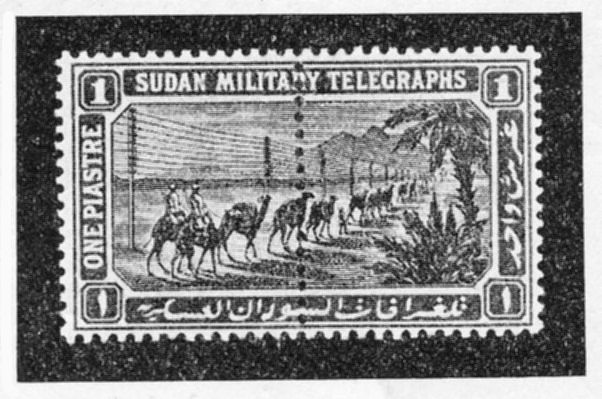 402
402
Morocco.—Following upon the proclamation of Egypt as a British Protectorate, it was announced that Great Britain has recognised the French Protectorate in Morocco and has adhered to the Franco-Moroccan Treaty of March 30, 1912. The French stamps for Morocco (Fig. 403) have now been overprinted "PROTECTORAT-FRANCAIS", as may be seen by comparing this 10 centimes value with the same denomination utilised for Red Cross stamp purposes (Fig. 153). The change in the status of Morocco may render the British postal agencies there unnecessary, in which case the series of British stamps overprinted "MOROCCO AGENCIES" (Figs. 404, 405) may be rendered obsolete.
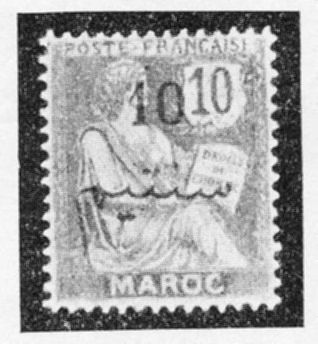 403
403
Postcards and Postmarks. The remaining illustrations, added as this work is being sent to press, supplement the philatelic records of the present war, as already outlined in the earlier chapters. Fig. 406 is the original issue of the French military postcard, on thin green card. Fig. 407 is also French, printed on a thicker Silurian card. Fig. 408 is a German field postcard (medium white) despatched by a British prisoner of war in the English Lager at Sennelager. A few additional naval postmarks are also shown (Figs. 409-413). Fig. 409 appears to be in the design of an "Iron Cross" (!) Fig. 414 is a mark used by the censor in handling registered mail, and 415 is on correspondence originating at a depot for convalescent horses. Figs. 416-420 are various types of censor marks, No. 419 being a Dutch one on a letter posted at Maastricht. At the time of going to press we have noted British military censor marks up to No. 1739. We are also able to state definitely that Fig. 85B (Chapter II.) is a field postmark of the Indian Expeditionary Force in France.
 417 418
417 418
Transcriber's Notes:
Changes to the text have been limited to typographical errors. These are listed below with other observations:
Page 5, "47" changed to "49" (in Table of Contents: Chapter IV ... page 49.)
Page 5, "77" changed to "75" (in Table of Contents: Chapter VI ... page 75.)
Page 5, an Appendix starting on p. 122 is not listed in the Table of Contents.
Page 32, Figure 69 originally on page 32 moved to page 33; appears as illustration for HTML version and is transcribed as text for this Plain Text version.
Page 33, note hand-written correction to the poster (Figure 69) "stamps" should read "letters" (unpaid and unfranked letters will also run the risk of misdelivery.)
Page 36, missing closing parenthesis added "(Fig. 77)".
Page 45, there is no Figure 123.
Page 45, "129" changed to "128" ("Figs. 126-128".)
Pages 57 & 58, duplicate use of figure numbers 167 and 168.
Page 59, "Womens'" changed to "Womens'" (the Imperial Women's Patriotic Union.)
Page 70, Figure 221 appears as illustration for HTML version and is transcribed as text for this Plain Text version.
Page 76, "Fraulein" changed to "Fräulein" (an actress Fräulein Anna Führing).
Page 87, suspected error in original left unchanged: "susceptibilities" for "sensibilities" (which gave offence to Muslim susceptibilities).
Page 103, "incriptions" changed to "inscriptions" (the inscriptions on which read "Liberty or death...")
Page 108, in the transcription of the overprint "HALILITADO POR LA JUNTA REVOLUCIONARIA" it is unclear whether "HALILITADO" is an error for "HABILITADO" in the typesetting or in the original overprint.
Page 122, "Pharoahs" changed to "Pharaohs" (postage stamps of the land of the Pharaohs).
End of Project Gutenberg's The Postage Stamp in War, by Fred. J. Melville
*** END OF THIS PROJECT GUTENBERG EBOOK THE POSTAGE STAMP IN WAR ***
***** This file should be named 34007-h.htm or 34007-h.zip *****
This and all associated files of various formats will be found in:
https://www.gutenberg.org/3/4/0/0/34007/
Produced by Simon Gardner, Adrian Mastronardi, The
Philatelic Digital Library Project at http://www.tpdlp.net
and the Online Distributed Proofreading Team at
https://www.pgdp.net
Updated editions will replace the previous one--the old editions
will be renamed.
Creating the works from public domain print editions means that no
one owns a United States copyright in these works, so the Foundation
(and you!) can copy and distribute it in the United States without
permission and without paying copyright royalties. Special rules,
set forth in the General Terms of Use part of this license, apply to
copying and distributing Project Gutenberg-tm electronic works to
protect the PROJECT GUTENBERG-tm concept and trademark. Project
Gutenberg is a registered trademark, and may not be used if you
charge for the eBooks, unless you receive specific permission. If you
do not charge anything for copies of this eBook, complying with the
rules is very easy. You may use this eBook for nearly any purpose
such as creation of derivative works, reports, performances and
research. They may be modified and printed and given away--you may do
practically ANYTHING with public domain eBooks. Redistribution is
subject to the trademark license, especially commercial
redistribution.
*** START: FULL LICENSE ***
THE FULL PROJECT GUTENBERG LICENSE
PLEASE READ THIS BEFORE YOU DISTRIBUTE OR USE THIS WORK
To protect the Project Gutenberg-tm mission of promoting the free
distribution of electronic works, by using or distributing this work
(or any other work associated in any way with the phrase "Project
Gutenberg"), you agree to comply with all the terms of the Full Project
Gutenberg-tm License (available with this file or online at
https://gutenberg.org/license).
Section 1. General Terms of Use and Redistributing Project Gutenberg-tm
electronic works
1.A. By reading or using any part of this Project Gutenberg-tm
electronic work, you indicate that you have read, understand, agree to
and accept all the terms of this license and intellectual property
(trademark/copyright) agreement. If you do not agree to abide by all
the terms of this agreement, you must cease using and return or destroy
all copies of Project Gutenberg-tm electronic works in your possession.
If you paid a fee for obtaining a copy of or access to a Project
Gutenberg-tm electronic work and you do not agree to be bound by the
terms of this agreement, you may obtain a refund from the person or
entity to whom you paid the fee as set forth in paragraph 1.E.8.
1.B. "Project Gutenberg" is a registered trademark. It may only be
used on or associated in any way with an electronic work by people who
agree to be bound by the terms of this agreement. There are a few
things that you can do with most Project Gutenberg-tm electronic works
even without complying with the full terms of this agreement. See
paragraph 1.C below. There are a lot of things you can do with Project
Gutenberg-tm electronic works if you follow the terms of this agreement
and help preserve free future access to Project Gutenberg-tm electronic
works. See paragraph 1.E below.
1.C. The Project Gutenberg Literary Archive Foundation ("the Foundation"
or PGLAF), owns a compilation copyright in the collection of Project
Gutenberg-tm electronic works. Nearly all the individual works in the
collection are in the public domain in the United States. If an
individual work is in the public domain in the United States and you are
located in the United States, we do not claim a right to prevent you from
copying, distributing, performing, displaying or creating derivative
works based on the work as long as all references to Project Gutenberg
are removed. Of course, we hope that you will support the Project
Gutenberg-tm mission of promoting free access to electronic works by
freely sharing Project Gutenberg-tm works in compliance with the terms of
this agreement for keeping the Project Gutenberg-tm name associated with
the work. You can easily comply with the terms of this agreement by
keeping this work in the same format with its attached full Project
Gutenberg-tm License when you share it without charge with others.
1.D. The copyright laws of the place where you are located also govern
what you can do with this work. Copyright laws in most countries are in
a constant state of change. If you are outside the United States, check
the laws of your country in addition to the terms of this agreement
before downloading, copying, displaying, performing, distributing or
creating derivative works based on this work or any other Project
Gutenberg-tm work. The Foundation makes no representations concerning
the copyright status of any work in any country outside the United
States.
1.E. Unless you have removed all references to Project Gutenberg:
1.E.1. The following sentence, with active links to, or other immediate
access to, the full Project Gutenberg-tm License must appear prominently
whenever any copy of a Project Gutenberg-tm work (any work on which the
phrase "Project Gutenberg" appears, or with which the phrase "Project
Gutenberg" is associated) is accessed, displayed, performed, viewed,
copied or distributed:
This eBook is for the use of anyone anywhere at no cost and with
almost no restrictions whatsoever. You may copy it, give it away or
re-use it under the terms of the Project Gutenberg License included
with this eBook or online at www.gutenberg.org
1.E.2. If an individual Project Gutenberg-tm electronic work is derived
from the public domain (does not contain a notice indicating that it is
posted with permission of the copyright holder), the work can be copied
and distributed to anyone in the United States without paying any fees
or charges. If you are redistributing or providing access to a work
with the phrase "Project Gutenberg" associated with or appearing on the
work, you must comply either with the requirements of paragraphs 1.E.1
through 1.E.7 or obtain permission for the use of the work and the
Project Gutenberg-tm trademark as set forth in paragraphs 1.E.8 or
1.E.9.
1.E.3. If an individual Project Gutenberg-tm electronic work is posted
with the permission of the copyright holder, your use and distribution
must comply with both paragraphs 1.E.1 through 1.E.7 and any additional
terms imposed by the copyright holder. Additional terms will be linked
to the Project Gutenberg-tm License for all works posted with the
permission of the copyright holder found at the beginning of this work.
1.E.4. Do not unlink or detach or remove the full Project Gutenberg-tm
License terms from this work, or any files containing a part of this
work or any other work associated with Project Gutenberg-tm.
1.E.5. Do not copy, display, perform, distribute or redistribute this
electronic work, or any part of this electronic work, without
prominently displaying the sentence set forth in paragraph 1.E.1 with
active links or immediate access to the full terms of the Project
Gutenberg-tm License.
1.E.6. You may convert to and distribute this work in any binary,
compressed, marked up, nonproprietary or proprietary form, including any
word processing or hypertext form. However, if you provide access to or
distribute copies of a Project Gutenberg-tm work in a format other than
"Plain Vanilla ASCII" or other format used in the official version
posted on the official Project Gutenberg-tm web site (www.gutenberg.org),
you must, at no additional cost, fee or expense to the user, provide a
copy, a means of exporting a copy, or a means of obtaining a copy upon
request, of the work in its original "Plain Vanilla ASCII" or other
form. Any alternate format must include the full Project Gutenberg-tm
License as specified in paragraph 1.E.1.
1.E.7. Do not charge a fee for access to, viewing, displaying,
performing, copying or distributing any Project Gutenberg-tm works
unless you comply with paragraph 1.E.8 or 1.E.9.
1.E.8. You may charge a reasonable fee for copies of or providing
access to or distributing Project Gutenberg-tm electronic works provided
that
- You pay a royalty fee of 20% of the gross profits you derive from
the use of Project Gutenberg-tm works calculated using the method
you already use to calculate your applicable taxes. The fee is
owed to the owner of the Project Gutenberg-tm trademark, but he
has agreed to donate royalties under this paragraph to the
Project Gutenberg Literary Archive Foundation. Royalty payments
must be paid within 60 days following each date on which you
prepare (or are legally required to prepare) your periodic tax
returns. Royalty payments should be clearly marked as such and
sent to the Project Gutenberg Literary Archive Foundation at the
address specified in Section 4, "Information about donations to
the Project Gutenberg Literary Archive Foundation."
- You provide a full refund of any money paid by a user who notifies
you in writing (or by e-mail) within 30 days of receipt that s/he
does not agree to the terms of the full Project Gutenberg-tm
License. You must require such a user to return or
destroy all copies of the works possessed in a physical medium
and discontinue all use of and all access to other copies of
Project Gutenberg-tm works.
- You provide, in accordance with paragraph 1.F.3, a full refund of any
money paid for a work or a replacement copy, if a defect in the
electronic work is discovered and reported to you within 90 days
of receipt of the work.
- You comply with all other terms of this agreement for free
distribution of Project Gutenberg-tm works.
1.E.9. If you wish to charge a fee or distribute a Project Gutenberg-tm
electronic work or group of works on different terms than are set
forth in this agreement, you must obtain permission in writing from
both the Project Gutenberg Literary Archive Foundation and Michael
Hart, the owner of the Project Gutenberg-tm trademark. Contact the
Foundation as set forth in Section 3 below.
1.F.
1.F.1. Project Gutenberg volunteers and employees expend considerable
effort to identify, do copyright research on, transcribe and proofread
public domain works in creating the Project Gutenberg-tm
collection. Despite these efforts, Project Gutenberg-tm electronic
works, and the medium on which they may be stored, may contain
"Defects," such as, but not limited to, incomplete, inaccurate or
corrupt data, transcription errors, a copyright or other intellectual
property infringement, a defective or damaged disk or other medium, a
computer virus, or computer codes that damage or cannot be read by
your equipment.
1.F.2. LIMITED WARRANTY, DISCLAIMER OF DAMAGES - Except for the "Right
of Replacement or Refund" described in paragraph 1.F.3, the Project
Gutenberg Literary Archive Foundation, the owner of the Project
Gutenberg-tm trademark, and any other party distributing a Project
Gutenberg-tm electronic work under this agreement, disclaim all
liability to you for damages, costs and expenses, including legal
fees. YOU AGREE THAT YOU HAVE NO REMEDIES FOR NEGLIGENCE, STRICT
LIABILITY, BREACH OF WARRANTY OR BREACH OF CONTRACT EXCEPT THOSE
PROVIDED IN PARAGRAPH 1.F.3. YOU AGREE THAT THE FOUNDATION, THE
TRADEMARK OWNER, AND ANY DISTRIBUTOR UNDER THIS AGREEMENT WILL NOT BE
LIABLE TO YOU FOR ACTUAL, DIRECT, INDIRECT, CONSEQUENTIAL, PUNITIVE OR
INCIDENTAL DAMAGES EVEN IF YOU GIVE NOTICE OF THE POSSIBILITY OF SUCH
DAMAGE.
1.F.3. LIMITED RIGHT OF REPLACEMENT OR REFUND - If you discover a
defect in this electronic work within 90 days of receiving it, you can
receive a refund of the money (if any) you paid for it by sending a
written explanation to the person you received the work from. If you
received the work on a physical medium, you must return the medium with
your written explanation. The person or entity that provided you with
the defective work may elect to provide a replacement copy in lieu of a
refund. If you received the work electronically, the person or entity
providing it to you may choose to give you a second opportunity to
receive the work electronically in lieu of a refund. If the second copy
is also defective, you may demand a refund in writing without further
opportunities to fix the problem.
1.F.4. Except for the limited right of replacement or refund set forth
in paragraph 1.F.3, this work is provided to you 'AS-IS' WITH NO OTHER
WARRANTIES OF ANY KIND, EXPRESS OR IMPLIED, INCLUDING BUT NOT LIMITED TO
WARRANTIES OF MERCHANTIBILITY OR FITNESS FOR ANY PURPOSE.
1.F.5. Some states do not allow disclaimers of certain implied
warranties or the exclusion or limitation of certain types of damages.
If any disclaimer or limitation set forth in this agreement violates the
law of the state applicable to this agreement, the agreement shall be
interpreted to make the maximum disclaimer or limitation permitted by
the applicable state law. The invalidity or unenforceability of any
provision of this agreement shall not void the remaining provisions.
1.F.6. INDEMNITY - You agree to indemnify and hold the Foundation, the
trademark owner, any agent or employee of the Foundation, anyone
providing copies of Project Gutenberg-tm electronic works in accordance
with this agreement, and any volunteers associated with the production,
promotion and distribution of Project Gutenberg-tm electronic works,
harmless from all liability, costs and expenses, including legal fees,
that arise directly or indirectly from any of the following which you do
or cause to occur: (a) distribution of this or any Project Gutenberg-tm
work, (b) alteration, modification, or additions or deletions to any
Project Gutenberg-tm work, and (c) any Defect you cause.
Section 2. Information about the Mission of Project Gutenberg-tm
Project Gutenberg-tm is synonymous with the free distribution of
electronic works in formats readable by the widest variety of computers
including obsolete, old, middle-aged and new computers. It exists
because of the efforts of hundreds of volunteers and donations from
people in all walks of life.
Volunteers and financial support to provide volunteers with the
assistance they need are critical to reaching Project Gutenberg-tm's
goals and ensuring that the Project Gutenberg-tm collection will
remain freely available for generations to come. In 2001, the Project
Gutenberg Literary Archive Foundation was created to provide a secure
and permanent future for Project Gutenberg-tm and future generations.
To learn more about the Project Gutenberg Literary Archive Foundation
and how your efforts and donations can help, see Sections 3 and 4
and the Foundation web page at https://www.pglaf.org.
Section 3. Information about the Project Gutenberg Literary Archive
Foundation
The Project Gutenberg Literary Archive Foundation is a non profit
501(c)(3) educational corporation organized under the laws of the
state of Mississippi and granted tax exempt status by the Internal
Revenue Service. The Foundation's EIN or federal tax identification
number is 64-6221541. Its 501(c)(3) letter is posted at
https://pglaf.org/fundraising. Contributions to the Project Gutenberg
Literary Archive Foundation are tax deductible to the full extent
permitted by U.S. federal laws and your state's laws.
The Foundation's principal office is located at 4557 Melan Dr. S.
Fairbanks, AK, 99712., but its volunteers and employees are scattered
throughout numerous locations. Its business office is located at
809 North 1500 West, Salt Lake City, UT 84116, (801) 596-1887, email
business@pglaf.org. Email contact links and up to date contact
information can be found at the Foundation's web site and official
page at https://pglaf.org
For additional contact information:
Dr. Gregory B. Newby
Chief Executive and Director
gbnewby@pglaf.org
Section 4. Information about Donations to the Project Gutenberg
Literary Archive Foundation
Project Gutenberg-tm depends upon and cannot survive without wide
spread public support and donations to carry out its mission of
increasing the number of public domain and licensed works that can be
freely distributed in machine readable form accessible by the widest
array of equipment including outdated equipment. Many small donations
($1 to $5,000) are particularly important to maintaining tax exempt
status with the IRS.
The Foundation is committed to complying with the laws regulating
charities and charitable donations in all 50 states of the United
States. Compliance requirements are not uniform and it takes a
considerable effort, much paperwork and many fees to meet and keep up
with these requirements. We do not solicit donations in locations
where we have not received written confirmation of compliance. To
SEND DONATIONS or determine the status of compliance for any
particular state visit https://pglaf.org
While we cannot and do not solicit contributions from states where we
have not met the solicitation requirements, we know of no prohibition
against accepting unsolicited donations from donors in such states who
approach us with offers to donate.
International donations are gratefully accepted, but we cannot make
any statements concerning tax treatment of donations received from
outside the United States. U.S. laws alone swamp our small staff.
Please check the Project Gutenberg Web pages for current donation
methods and addresses. Donations are accepted in a number of other
ways including including checks, online payments and credit card
donations. To donate, please visit: https://pglaf.org/donate
Section 5. General Information About Project Gutenberg-tm electronic
works.
Professor Michael S. Hart was the originator of the Project Gutenberg-tm
concept of a library of electronic works that could be freely shared
with anyone. For thirty years, he produced and distributed Project
Gutenberg-tm eBooks with only a loose network of volunteer support.
Project Gutenberg-tm eBooks are often created from several printed
editions, all of which are confirmed as Public Domain in the U.S.
unless a copyright notice is included. Thus, we do not necessarily
keep eBooks in compliance with any particular paper edition.
Most people start at our Web site which has the main PG search facility:
https://www.gutenberg.org
This Web site includes information about Project Gutenberg-tm,
including how to make donations to the Project Gutenberg Literary
Archive Foundation, how to help produce our new eBooks, and how to
subscribe to our email newsletter to hear about new eBooks.